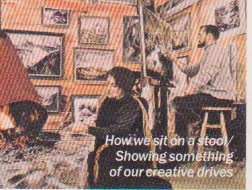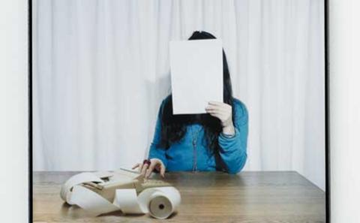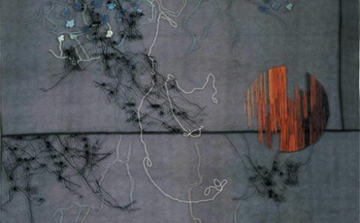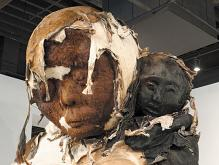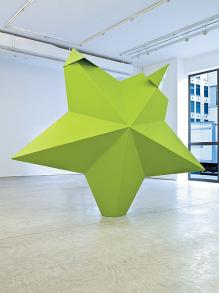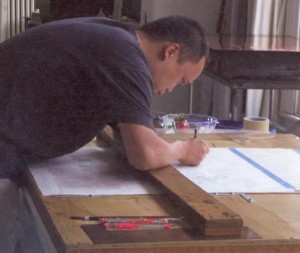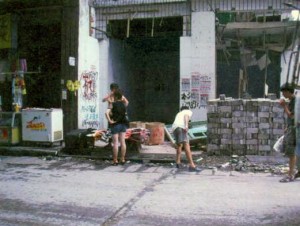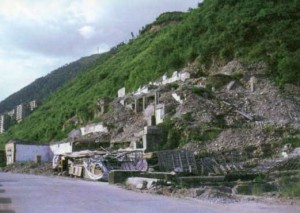If you enjoyed my recent post featuring Brazilian artist Maria Nepomuceno’s vibrant abstract sculpture, see more of this gorgeous exhibition in the video below. With her repeated curving, organic forms, Nepomuceno aims to represent movement into our own inner depths as well as an expansion into the infinite.
Jedediah Caesar at D’Amelio Gallery
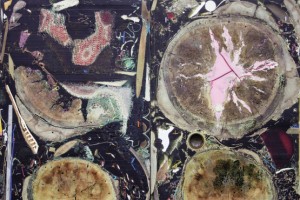
As he did for his 2010 show, Jedediah Caesar pairs gorgeously hued cast-resin sculptures with drabber offerings in his latest outing, necessitating an unfortunate choice for viewers: Fall back on enjoying the now-familiar resin pieces, or try to engage the work that’s not as compelling.
Caesar creates the former by embedding found objects (in this case, rocks collected in the Mojave Desert) into blocks of variously colored resins, before slicing the forms like a loaf of bread to reveal whatever formal arrangements chance created. The latter are represented here by three bulky, sand-castle-like sculptures made of clay, stamped with the imprint of various hard-to-identify items sourced in New York. The impressions left behind include wedge shapes, dots and dents suggesting a little pig sticking its nose where it didn’t belong. Unlike the resin pieces, which have an insect-trapped-in-amber allure, the clay works seem inert, presenting a sense of disconnection in lieu of a poetic evocation of absence.
For some of his previous resin pieces, Caesar sawed off thin tiles to form stacks, or grids on the walls. Here the highlight consists of similar rectangles assembling into a baseboard around the gallery, proceeding in the order in which they were originally cut. This affords an opportunity to see how various patterns unfold and surprising associations arise. Klimt’s jewellike decorations come to mind, but at heart, Caesar’s process is about making the mundane seem extraordinary—or at least aesthetically pleasing.
Aaron Curry, ‘Buzz Kill’ at Michael Werner
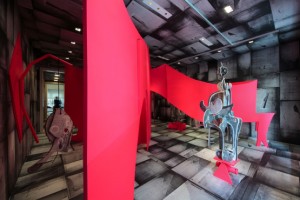
When asked how he felt about his imitators in a 1962 interview, Alexander Calder replied, “They nauseate me.” Aaron Curry’s recent sculptures—which continue to blatantly quote the biomorphic forms pioneered by Calder, Frederick Kiesler and other High Modernists—suggest he wouldn’t mind irking his art-historical predecessors. The show’s tongue-in-cheek centerpiece, Buzz Kill (a hot-red rendition of a Calder-like stabile in aluminum), as well as other sculptures featuring curvy interlocking shapes à la Kiesler and Noguchi, seems eager to take down modernism’s utopian ideals without offering much in their place.
The space-hogging Buzz Kill—along with a grainy black-and-white wallpaper of Minimalist collage patterns that plasters the space, floor and ceiling included—hints at a major statement by aggressively altering the gallery’s townhouse setting. But the work fails to go beyond a kill-the-father treatment of modern art. A recurring image within the wallpaper resembles a straight razor at first glance, and a disembodied cardboard “head” briefly conjures dread, before the limp phallic protrusion it dangles from disperses any serious reaction.
The pieces in the foyer (small paper collages featuring a sci-fi sex-goddess type atop a primitive sculpture, and an alien head affixed to a nude female totem) prime viewers for a transgressive punch that the exhibition fails to deliver. Instead, we get more of the artist’s now-signature wooden sculptures composed of organic, interlocking shapes, including Dezvil, which doesn’t resemble an evil presence so much as a goofy moose with someone clinging to its back. The modernist hope of creating a harmonious society through art may be dead, but stasis and pastiche aren’t suitable replacements.
Virginia Overton at The Kitchen
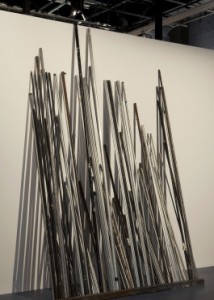
Virginia Overton’s habit of using unexpected objects to challenge our experiences of a particular space would seem well suited to the Kitchen. Yet the five sculptures she presents in this exhibit—made from steel pipes, two-by-fours, pedestals and other items collected behind the scenes at this venerable nonprofit—don’t greatly alter our sense of the institution, though they do reflect on the relevance of Minimalism today.
In the past, Overton’s sculptures have sometimes involved startling incongruences, but the pieces here—like a collection of well-used rigging poles propped against the wall and lit to create an elegant installation—look more attractive than out of place. Others carry on a more overt conversation with 1960s Minimalist art, such as the strongly spotlit, diagonally wall-mounted steel bar that recalls a Flavin fluorescent tube, or the floor-bound array of creaky two-by-fours that noisily raise one’s awareness of his or her footsteps, à la Carl Andre.
These two pieces and others touch on Minimalism’s penchant for interacting with or altering the exhibition space, but Overton ostensibly wants to elicit a deeper understanding of the venue’s identity (in this case, as a gallery and a theater). By quoting Minimalist aesthetics, she brings to mind concerns with light, space and viewer participation, all topics clearly relevant to the Kitchen’s history as a performance center. Considering the highly experimental nature of that history, however, Overton could have taken more risks, instead of just settling for tasteful arrangements.
Monica Cook, ‘Volley’ at Postmasters

Figurative sculpture of fantastical creatures being rare in Chelsea, Monica Cook’s first New York solo show starts out as strange, but gets more eccentrically alluring. A monkey-like character by the door sets the tone with a dignified look in his eye but a half-finished, diseased-looking body. His simian brethren, in sculptures, photos and a stop-animation video, are equally grotesque, cobbled together assortments of fur and plastic. They recall David Altmejd’s gaudy giants, but elicit more sympathy.
A parent-and-child grouping and a female with her dog hint at the possibility that the beasts are stand-ins for us humans. This suggestion is confirmed by the video, in which the critters court and mate in a manner recalling Cook’s excellent 2010 YouTube Play contribution (not in the show), featuring romantic encounters driven by bestial desires. Things work out better in Cook’s animal kingdom, however, as ulterior motives fall by the wayside and, after a series of shy glances, a male magically impregnates a female by merely proffering her a bauble.
The fact that this pretty seed was torn from a fetus-like pod, or that the female attracts the male by munching on an olive-like oval pulled from the skin of her leg, is the repulsive flip side to these creatures’ damaged beauty. Missing flesh reveals skeletons cleverly constructed from coiled phone cords, internal organs made of glass balls and baboon bottoms filigreed with lingerie-like ornamentation. Despite their disconcerting appearance, their rituals of attraction and reproduction are sincere and absurdly simple, offering a kind of prelapsarian seduction of their own.
Uta Barth Solo Show at Tanya Bonakdar Gallery

The centerpiece of Uta Barth’s latest solo show is a photo series depicting a continually morphing strip of light beneath her living-room curtains, a preposterously simple conceit which nevertheless yields complex optical illusions. As this diaphanous sliver shifts course over an afternoon, it variously resembles a snake, a line on an EKG or a trail of cigarette smoke, all the while transforming the space between the camera, the curtain and the window into an ambiguous territory where volumes flatten or swell, and light can pass for white paint.
Two glimpses of Barth’s hand arranging the curtain folds remind us of her agency, but it’s nature’s hand that propels the work’s attractively simple narrative as the sun’s changing position gradually increases the width of the band. At this time of year, as the onset of winter makes Barth’s invitation to contemplate sunlight especially attractive, the work entices us into the pleasures of solitary idleness that are at odds with the pace of everyday urban life.
In the back room, by comparison, a second group of photographs depicting built-in closets and drawers in the artist’s bedroom seems coldly architectural. Each image is emblazoned by squares or rectangles of light cast from an opposite window: One features a particularly bright patch that suggests celestial or alien visitation; another, a band of shadow over a door latch, creates the illusion that the surface of the print is scratched. But otherwise, the real drama of transformation takes place in the front gallery.
Originally published in Time Out New York, issue 839, Dec 1-7, 2001.
Sarah Braman, “Yours” at Mitchell-Innes and Nash
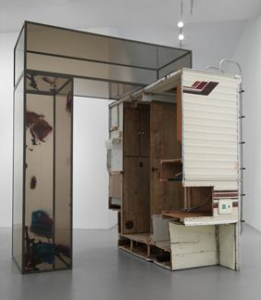
Sarah Braman’s trademark combinations of disparate materials in precarious arrangements achieve a new level of gravity with the incorporation of components from a cut-up camper. In her debut at Mitchell-Innes & Nash, hefty chunks of the vehicle act as both painting surface and gritty foil to the clean-cut cubes of gorgeous blue and purple Plexiglas to which they are sometimes conjoined. The resulting juxtapositions defy expectations as the funky, roughed-up trailer becomes impersonal, and the slick geometric elements charm with their transparent beauty.
In a sculpture near the gallery entrance, the back of the RV creates an archway with two Plexi boxes forming an L. Tinted the color of limousine windows, the latter are doodled with spray paint, recalling Sterling Ruby’s defaced pedestal pieces, but without the air of menace. If this treatment somewhat softens these cold, corporate forms, a lack of any trace of habitation within the camper does the opposite, making it makes seem less like a repository of past adventures, à la Mike Nelson’s airstream installation at 303 Gallery last spring, and more like one of Gordon Matta-Clark’s deconstructions of an abandoned place.
In a piece titled 8pm, a smaller fragment of the camper is sandwiched between two aquarium-like shapes, while a larger nearby structure in blue, pink and purple Plexi recalls an empty Damien Hirst shark tank crossed with an Anne Truitt. But it is in Braman’s misleadingly titled and exceedingly lively Coffin that viewers are finally offered the delayed gratification of imagining past lives. Here the Plexiglas takes something of a backseat to a segment of camper laid with a mirrored floor, creating a boudoir-like stage for memories.
Originally published in Time Out New York, issue 837, November 17-23, 2011.
Tris Vonna-Michell at Metro Pictures Gallery
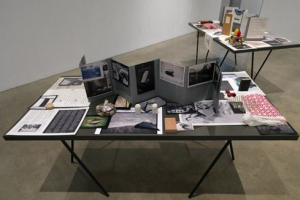
In his New York gallery debut, British artist Tris Vonna-Michell explores the stories of little-known historical figures (an East German border guard, a forgotten concrete poet) in a group of distinct but linked installations that collect, sift and reconfigure information to create intriguing, and charmingly quixotic, alternative histories. Despite deliberately low-tech, low-key visuals—slide shows of bleak urban scenes, displays of texts on tables and shelves—the artist’s soundtrack of urgently delivered word streams provides an irresistible hook.
In the darkened front gallery, a voice speaks pressingly about magnetic tapes, tanks and Russians, while a projector slowly flashes images of the former no-man’s-land near the Berlin Wall. Texts spell out the story of a young soldier canonized by the East German state for being shot by defectors escaping west in 1962, but the actual details are left untold because, as the piece suggests, truth was subsumed by official legend long ago.
Elsewhere, Vonna-Michell tells of his not entirely successful attempt to track down an obscure French avant-garde poet, Henri Chopin (a former neighbor), and also recalls the 1989 mass demonstrations around Stasi headquarters in Leipzig, as nervous authorities shredded incriminating files inside. Seamlessly segueing from their frantic efforts to destroy records to Kurt Schwitters’s collage technique, Vonna-Michell demonstrates that while none of us may ever completely know the past, it can be engaged, at least, on one’s own terms.
Originally published in Time Out New York, issue 832, October 13-19, 2011.
Matthew Ronay, “Between the Worlds” at Andrea Rosen Gallery
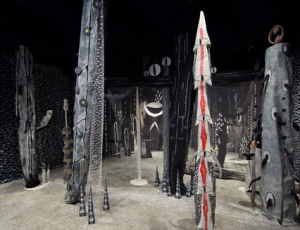
Four years after Matthew Ronay overhauled his style from comic grotesque to soberly spiritual, his ambitious new installation feels like an apotheosis. Dramatically veiled behind a huge black curtain, an enchanted forest populated by birds of prey, totemic figures and fertility symbols invites pleasurable discovery and even a sense of wonder at the level of detail, imagination and effort involved. A lingering question remains, however, as to what you’re supposed to do with this otherworldly space.
Considering that Ronay’s previous pieces have included sculptures of hamburgers alongside delicately arching penises with bites taken out of them, it’s hard to believe that the artist is being entirely straight-faced here. In the gallery handout, he suggests that he wants to give gallerygoers an opportunity to transcend the quotidian by offering them a genuine spiritual experience. Yet with all the papier-mâché volcanoes, trees made of Ikea-like prints, diminutive beings and the cutest owls this side of Disney lying about, they’ll have to stop chuckling first.
Abundant mushroom imagery (growing on felled trees, hanging in chains) suggests some sort of transport of the mind. But it’s the commanding Masculine Pillar—a robed column with a giant eyelike symbol—that grabs attention by virtue of appearing to conceal someone inside, as it did on the show’s opening night, when Ronay occupied it. Which is a reminder that while forests are classic settings for fantastical tales, characters are what make a story, so Ronay’s installation feels a little hollow when it’s empty. Without the presence of a person, the installation is like a stage set, and all the totems simply props with no ritual significance to add to their relevance. Thus, the piece’s potential to achieve the artist’s hoped-for transcendence is diminished.
Originally published in Time Out New York, issue 823, August 4-10, 2011.
“The House Without the Door” at David Zwirner Gallery
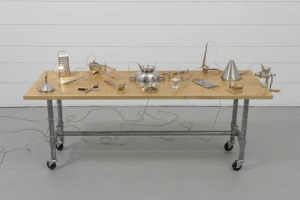
Mona Hatoum’s 1999 sculpture Home (featuring kitchen implements with wires running out of them, accompanied by the sound of pulsating current) inspired this unsettling exhibition plumbing the darker side of the places in which we live. High on anxiety but regrettably low on risk factor, this hit parade of big-name artists still affords the pleasure of reconnecting with iconic artworks about painful circumstances.
Family relations simmer in the show’s best pieces. Louise Bourgeois’s claustrophobic house teeming with phallic/breast/fungal forms and Rachel Whiteread’s black urethane mattress creased by a labial fold conjure a dread matched by a Luc Tuymans painting of place settings that foretells the drama of a family gathering.
Violence spills over in Gregor Schneider’s photos of a strung-up sex doll and in Mamma Andersson’s painting of a disordered bedroom with ominously bloodred furniture. But the most disturbing pieces hint at souls lost to the chaos (Jeff Wall’s photo of a disheveled character standing by the door of his decrepit domicile) or obsessive order (a Thomas Ruff living-room scene) of their lives.
Even a cheery painting of a beach house by Maureen Gallace turns suspiciously, unbelievably idealized in this context, while a whimsical paintbrush by Michael Brown, its handle crafted from melted Neil Young records, seems primed for a cover-up. Viewed from the right angle, David Altmejd’s plaster sculpture of a fantastical lair with dangling staircases turns out to be the head of some deranged giant. Such twists add intrigue to this domestic thriller of a group show.
Paul Sietsema at Matthew Marks Gallery
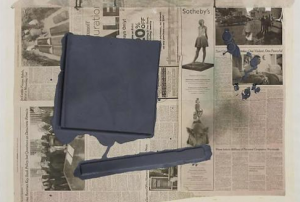
If it weren’t for the schooner by the doorway at Paul Sietsema’s first New York gallery solo, I’d have missed the boat. Not-quite-right details reveal that what looks like an aged old photograph of a sailboat is in fact a meticulous drawing that demonstrates in a flash how painterly skill adds value and interest to an artwork. In this otherwise aesthetically restrained but intellectually stimulating show, Sietsema allows trace evidence of his hand in pieces that look digitally produced or printed, questioning his own role as a craftsman in the digital age and floating an inconclusive but engaging argument that artistic survival means cleverly thwarting expectations.
In the past, Sietsema has exhibited films of sculptural objects; the drawings here allow us the intimacy to appreciate his handiwork. Two untitled pieces resembling expressive abstractions in black ink also include depictions of bottles of Krylon ‘Short Cuts’ paint, humorously highlighting how Sietsema doesn’t take shortcuts in his labor intensive, cerebral, and non-emotive project. At the bottom of one, the phrase “broken down and experimental…broken down beauty,” bespeaks the pleasure of piecing together Sietsema’s deconstructions.
Two pieces titled, ‘Painter’s Mussel’ refer to shells used to hold paint but show Sietsema flexing his intellectual muscle in complicated pictures of disassembled framed photographs drawn to resemble photographic negatives which appear to have been printed. From the aged photograph of the boat and images that pit old technology (the brush) with new, to two pieces replicating the dated medium of newspaper pages (including an article on Obama reversing a Bush policy) Sietsema suggests that with passage of time ascendency fades – the smart artist adapts by working outside of traditional expectations.
Condensed version of this review published in Time Out New York, issue 815, June 2-8, 2011.
Laurel Nakadate at Leslie Tonkonow Artworks and Projects

Laurel Nakadate cried every day of 2010. And whether she was in her apartment, in an airplane lavatory or on a beach, she captured the result in 365 photographs, meant to document her effort, as she put it, to “deliberately take part in sadness.” Contrary to this suggestion of shared unhappiness, however, the images portray her in isolation. Often nude or semiclothed, she plays the role of a vulnerable woman needing rescue, appearing to offer her body in a compromised sexual exchange for attention. Sensational, narcissistic, yet incisively illuminating in some respects, Nakadate’s project is an uncomfortable portrait of alienation.
It also tests our willingness to indulge in so much self-inflicted pain. The seasons and the artist’s travels introduce a minor narrative arc, but there’s no resolution to her misery. Unlike Tehching Hsieh’s yearlong performances tracking the effects of self-imprisonment, or Eleanor Antin’s photo diary of being on a diet, Nakadate undergoes no transformation and promotes no politics, personal or otherwise. And unlike the lovelorn Sophie Calle’s exhaustive investigation of a Dear John letter, there is no catharsis.
Instead, the act of repetition dominates, and the mind wanders to questions about Nakadate and her motives: How does she make herself cry? Is she merely acting? What goes on off-camera: Does she happily go about her day until the requisite moment to shed tears? Part of “365 Days” is on view at MoMA PS1, where the photographs are huge, implying an unwarranted monumentality to the artist’s questionably authentic emotion. Even in this more modest installation of smaller-size prints in a tight grid arrangement, Nakadate is still center stage, limiting any possible commentary on collective grief or widespread disaffection.
Originally published in Time Out New York, issue 815, June 2-8, 2011.
Angel Otero, “Memento” at Lehmann Maupin

Angel Otero’s unconventional process—fashioning assemblages or lively paintings using “skins” of oil paint applied to glass before being peeled off—is the draw in his New York solo debut. An awkward anthropomorphic object perched on a chintzy armchair, messy Expressionist interiors in garish colors and one uninspired composition with text demonstrate the young artist’s competing sensibilities. Far better are Otero’s large-scale abstractions—action paintings in which paint itself seems to have agency, shooting off the edge of the canvas, bunching dramatically or seductively veiling its support.
The show’s smallest and punchiest piece—a black number whose surface is concertinaed like a crushed soda can—has an affinity with Piero Manzoni’s pleated white canvas, but in place of purity there is an excess of paint, piled up in waves as if to hide some (perhaps failed?) experiment beneath. Likewise, a blocky form wrapped in streaks of yellow and black traffics in concealment, channeling Christo’s early wrapped objects—minus, unfortunately, the mystery.
The play between a vibrantly colored surface and an occasionally glimpsed support that is waxy and dead is more alive than, say, Steven Parrino’s twisted and pulled canvases, and aligns Otero with Fabian Marcaccio’s use of paint as a sculpting material. Recurrent blurring also recalls Gerhard Richter’s scraped abstract canvases, but unlike Richter, Otero’s intent is to build, not cancel out. His undulating skins re-create the drama of a hastily drawn curtain, awaking the senses and offering a celebration of paint’s possibilities.
Originally published in Time Out New York, issue 807, March 31 – April 6, 2011.
Yoan Capote, “Mental States” at Jack Shainman Gallery
Yoan Capote, a stand-out artist in the Havana scene, explained in a recent interview that he wants his work to remain relevant after the ‘political exoticism’ of Cuban art (fashionable since the mid-90s) dies down. In the meantime, his recent subject matter – the allures and disillusionment of migration – and his tendency towards often blunt, sometimes profound statements are the hallmarks of stereotypical Cuban style. Despite the feeling of déjà vu that this show evokes, Capote makes his mark by implicating everyone – us, himself, and Cubans in general – in the complex pleasures and pains of cross-cultural longing.
Capote opens the show with a literal bait-and-switch – a majestically vast (over 26 foot long) and gorgeously deserted seascape that turns out on closer inspection to be an intimidating composition made from thousands of fish hooks attached to the picture’s surface. An equally enticing sea view crops up again in a nearby video in which we watch a waterfront window being bricked in with the pattern of a U.S. flag in a claustrophobic ritual that replaces the imagined but unattainable reality of foreign lands beyond the horizon with a barricade both symbolic and literal.
Surprise menace and repressive restriction create an uneasy mood but leave room for personally inflected interpretation. More heavy-handed pieces kill the spirit of enquiry, as with a room-sized bronze set of scales titled ‘Status Quo (Reality and Idealism)’ that leaves no doubt about how privilege tips in favor of the already powerful. In a series titled ‘Coitus’, human silhouettes cut from dollar bills, pesos, rubles and Yuan play the one-dimensional role of symbolic aggressor or victim. But in pieces like ‘Migrant,’ in which two feet join to tree trunk legs that end in a complex network of roots, Capote pointedly testifies to the personal cost of uprootedness. Laid low on the gallery floor, roots echoing brain synapses make the poignant argument that when it comes to the linguistic, social or cultural nourishment of your native culture, you can’t take it with you.
Originally published in Flash Art International, issue 276, January/February, 2011.
Sean Bluechel, “Another with Suspension” at Nicole Klagsbrun Gallery
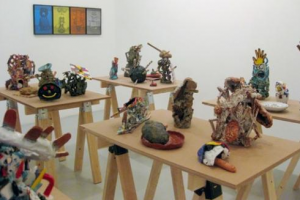
As far as quantity goes, the 36 ceramic sculptures and 25 photos crowding Nicole Klagsbrun’s side gallery suggest that Sean Bluechel is more than ready for his first major Chelsea show. In terms of quality, however, his creative profusion—and a goofy hedonism conveyed by ubiquitous smiley faces, multiple ceramic spliffs and an assortment of phallic objects ranging from digits to a corncob—threaten to distract from the show’s real gems: Remarkable shape-shifting objects conjure fantastical scenarios.
Though the ceramics are the main draw, Bluechel’s photos of totemic assemblages cobbled together from cardboard tubes, Styrofoam, tinsel, balloons and a very accommodating nude woman (who seems to have been shot in a basement) have a furtive quality, as well as a postdebauch air that is in keeping with the sculptures’ juxtaposition of lumpen forms and beautifully colored glazes. Yet they feel more like high jinks than high art.
Bluechel’s apparent references in a few of the sculptures to such artists as Jean Dubuffet and Yves Klein indicate that he’s mindful of the distinction. Yet his efforts work best when you overlook the visual hubbub of his busy installation and focus on select stand-alone pieces: the upside-down mushroom balanced on two blobs, titled Unshaved Wicca Girls; the quasi-camera/gun/musical instrument, rising from a dish amid a flurry of leaves, titledKill Vegans; the Kusama-channeling bouquet of protruding fingers crowned with a laurel. They all deliver their paeans to insouciant perversity with concision and humor.
Originally published in Time Out New York, issue 799, February 3-9, 2011.
Tiffany Pollack, “Room” at Gasser & Grunert, Inc.

In Tiffany Pollack’s second solo show, baby care and flowers are subjects for dyed silk paintings in glorious washes of beautiful color. The former take shape as quasimodernist grids charting the waking/napping routine of the artist’s infant. Given that mother-child relationships in contemporary art tend more toward the curdled Robert Melee variety, Pollack’s approach is surprisingly anxiety-free.
Though the show includes eight such paintings, Pollack crystallizes the experience of all-encompassing emotional highs and lows in a single piece that registers periods of happiness followed by tears. Like Mierle Laderman Ukeles’s memorable photos of her children’s slow progress in getting dressed to go out during winter, Pollack’s efforts will elicit groans of recognition, their wavy bands of color perfectly conveying the hazy disorientation of sleep deprivation.
Unlike Ukeles, however, or Catherine Opie’s gender-bending self-portrait while nursing, Pollack’s pretty colors and near-total lack of critical remove suggest that she’s enjoying her new role. Coupled with an eye-popping series of flower paintings in which poppies explode against a hot pink ground, bleeding-heart flowers dangle gorgeous buds, and the gathered stems of calla lilies melt together in a downward rush of paint, Pollack revels in the pleasures of fertility. These works recall Charles Ray’s much-lauded room of flowers at the last Whitney Biennial, though they leave hanging the question of whether highly personal exploration, beauty and, in Pollack’s case, pure joy are enough on their own.
Originally published in Time Out New York, issue 798, January 27 – February 2, 2011.
Matthew Monahan at Anton Kern Gallery
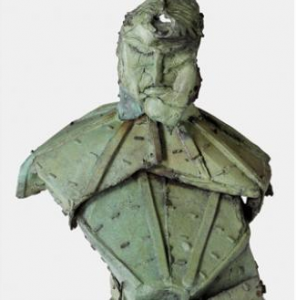
For a card-carrying member of the “Unmonumental” generation of sculptors (he was actually in the New Museum show of that name), Matthew Monahan’s latest freestanding bronze sculptures are both reactionary and a logical next step. His previous work consisted of installational displays crowded with objects and figures, idiosyncratic minimuseums chockablock with visual allusions to art history—a Greco-Indian eye here, a Northern Renaissance visage there. At Anton Kern, Monahan distills archetypal characters from a jumble of references, creating a fascinating group that looks like archaeological finds from an alternative art history.
One slender nude’s wire-bound body recalls photographer Nobuyoshi Araki’s soft-core titillations, but her quizzical expression is more provocative, suggesting spiritual superiority and/or mental disability. Another character’s cruciform pose begs explaining, but his craggy and practically concave face closes in as if guarding secrets. Nearby, a motionless, gold-leafed droid version of Umberto Boccioni’s Unique Forms of Continuity in Spacestands stiffly by.
While Monahan’s sculptures pique our curiosity with their mix of vague familiarity and uncertain identity, a series of oil-on-board images resembling tantric diagrams fairly exudes esoteric mystery. Collectively titled “Body Electric,” they summon Walt Whitman’s passionate appreciation of the human form but feature a fairly unnuanced, everyman element: a simplified kind of line drawing made by scraping black-painted paper to reveal the white below. The sculptures, on the other hand, turn appropriation into creation with their affecting cast and enjoyable synthesis of history, pop culture and sheer invention.
Originally published in Time Out New York, issue 793, December 9 – 15, 2010.
Kristin Morgin, “New York Be Nice” at Zach Feuer Gallery
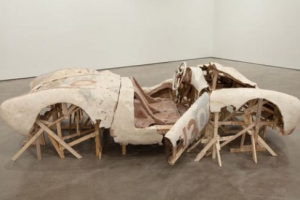
The nervous plea in the title of Kristen Morgin’s New York solo debut seems warranted at first glance. This accumulation of meticulously crafted, painted-ceramic replicas of comics, toys, personal mail and more, laid out on rickety tables, looks like the world’s most precious yard sale. But behind a facade of understatement, Morgin cleverly challenges the ways in which we value things, making art that’s real and fake, handcrafted and reproduced, imitative and innovative, vintage and new, high and low, all at the same time.
Category-busting begins at the door with a shelf of roughly fashioned teacups featuring portraits of comics icons, from Wonder Woman to Snoopy, a cheeky mix of useful craft and pop-indebted fine art. Elsewhere, doodles on Post-its lie alongside a ceramic Curious George book, featuring the trouble-prone primate traveling through space. Despite its futuristic theme, the tome’s deliberately cracked and aged condition and added-on sketches—including a version of Picasso’s Guernica—summon a specter of ruin over predigital ephemera. Large drawings of a dodo bird and ticking clocks rendered over other ceramic facsimiles of comic books likewise reinforce the sense of imminent extinction, reminding us that the past is always mediated.
What would ordinarily be the show’s star attraction—a pale and crumpled replica of the Porsche Spyder in which James Dean met his end—is the Bamiyan Buddha of roadsters: a memory so wrecked that it’s barely related to the original. Morgin, however, isn’t after the trompe l’oeil virtuosity of Steve Wolfe or even Allen Ruppersberg’s reshuffled pop references. Instead, she gives us a pointed warning that everything starting out shiny and new inevitably crumbles to dust.
Originally published in Time Out New York, issue 791, November 25-December 1, 2010.
“Greater New York” at PS1
The third of three blockbuster contemporary art survey shows to hit New York in the past year, Greater New York was worth waiting for. The New Museum’s youthfest, The Generational, showcased an under ripe generation still finding its voice. The Whitney Biennial presented artists self-consciously grappling with new ways to be ‘experimental.’ Despite the fact that these shows shared several artists, Greater New York swapped the previous ‘watch-this-space’ vibe for mature, confident work by 68 artists and collectives, evenly balanced between male and female, whose collective fostering of identity politics – sexual, racial, political and personal – broke with recent art world trends towards hermeticism and reconnected with the larger world.
If identity politics has come to sound retro in ‘post-black’ days, Hank Willis Thomas’ monumental photo series made it joltingly relevant, connecting yesterday to today by tracking the persistence of stereotype and recent fantasies of racial integration through forty years of magazine ads. Rashaad Newsome’s video of over twenty female performers uttering partial phrases like ‘excuuuuuse…’ or ‘giiirl’ is one of the best pieces at PS1 (though technically part of an auxiliary exhibition reviewing the last five years of artmaking), succinctly demonstrating how slang and role play create exclusive group identities.
Alternative sexuality was the norm in the third floor galleries, where Sharon Hayes’ five channel video installation ‘Revolutionary Love’ brilliantly integrated the concerns of participants inside and protesters outside the 2008 Democratic and Republican National Conventions before veering quixotically off topic by demanding love along with legal rights. But her assertion, ‘we’re all queer’ makes perfect sense in light of Leigh Ledare’s creepily incestuous photos of his exhibitionist mom, which prove that anyone, heterosexuals included, can pretty much chart their own course. LaToya Ruby Frazier’s photos of her own mother come to mind (from the New Museum Triennial); in her video contribution here, her tense, naked torso – juxtaposed with clouds of factory steam – pulsated with unspoken feeling.
Proving that identity politics don’t have to be dour, K8 Hardy’s fabulously eclectic self-portraits in outrageous getups place her characters outside recognizable ‘types.’ A similar inventive exuberance carries downstairs to A.L. Steiner’s photocollaged lesbian utopia where one nude joker embraces a reproduction of Courbet’s ‘Origins’ and another dangles her pendulous breasts over two globs of dough. Identity aside, other galleries exploded with color or formal inventiveness, including Kerstin Bratsch’s and Adele Roder’s abstract paintings, which distill distinctly a modernist appeal in terms of color and geometry, and Mariah Robertson’s audacious, show stopping 30” by 100’ photogram wrapped around gallery floor, walls, and ceiling.
Press material posited the ‘process of creation and the generative nature of the artist’s studio’ as the show’s dominant theme, though Robbinschild’s installation conveyed little when the artist’s weren’t present, Ei Arakawa gave out candy to studio visitors one day in apology for lack of a performance, and The Bruce High Quality Foundation’s program to swap new pedestals for used ones from art collages was a space-hogging one-liner. On the other hand, Naama Tsabar’s ‘Speaker Wall,’ two walls of bookshelf speakers rigged with strings into irresistible collaborative instruments, generated the hive of activity that the curators must have hoped for.
Tsabar’s invitation to engage in her work was literal, but for the most part, Greater New York’s best pieces stood out for their complex engagement with issues outside the art world (gay rights, racial, class and gender politics, etc). A couch featuring news clippings of President Obama and photos of a disfigured young Marine were among the most memorable images of the Whitney Biennial; likewise, pieces like David Brook’s living trees encased in concrete – a protest of deforestation in the Amazon, amongst other things – made the connection to an existing conversation amongst a wider audience, making this show the one we’ll likely continue to talk about.
Originally published in Flash Art International, no 274, October 2010.
Polly Apfelbaum, “Off Colour” at D’Amelio Terras

Polly Apfelbaum is in rebellion. Unlike the pleasing forms and intricate color schemes of the floor-based fabric arrangements she’s known for, her latest installation of jagged panels in sequined cloth is attention-grabbing but jarring. Off Colour derives its title and loud appearance from amateur nude photos that Apfelbaum found at a London flea market, suggesting a futile attempt at titillation.
At previous shows Apfelbaum had brought in work crafted in her workshop, but this installation was made directly in the gallery. The result—slender fabric strips extending into the corners or hugging columns—could barely be termed a response to this unremarkable space, though the artist has upended expectations by diverting our attention from the walls to the floor. Still, tiptoeing between the zones of crimson, pink, yellow, green and orange (that a sign warns us not to touch) is more awkward than absorbing; the scheme is so calculated that it discourages any desire for interaction.
On the plus side, the panels’ rough edges, geometry and scattered appearance recall Jean Arp’s torn-paper collages, and look like they might harbor some sort of meaningful relationship between the shapes and the negative spaces they create. Unfortunately, a more concrete reading is elusive, as if Apfelbaum had deliberately left behind a self-conscious collection of isolated parts that, like her source photos, lead us on but give us no satisfaction.
Originally published in Time Out New York, issue 785, October 14-20, 2010.
Liu Xiaodong, “Yan’ Guan Town” at Mary Boone Gallery
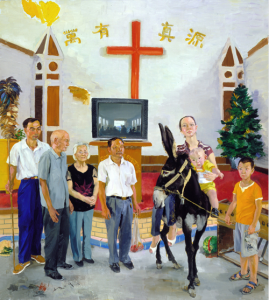
Coincidently, while Liu Xiaodong painted this show’s realist portraits of a Muslim and a Christian family in China’s northwestern Gansu province, ethnic violence broke out between Muslim and Han Chinese in the region. Rather than an argument for peaceful coexistence, however, this body of work seems more motivated by the artist’s curiosity about the unique cultural adaptations of China’s religious minorities.
Coincidently, while Liu Xiaodong painted this show’s realist portraits of a Muslim and a Christian family in China’s northwestern Gansu province, ethnic violence broke out between Muslim and Han Chinese in the region. Rather than an argument for peaceful coexistence, however, this body of work seems more motivated by the artist’s curiosity about the unique cultural adaptations of China’s religious minorities. Complicated family dynamics and Liu’s own idiosyncratic symbolism add animation to already fascinating portraits.
For example, Liu places the Christian brood of Z’s Family inside a chapel, with the young mother astride a donkey while holding her antsy toddler in her lap: an image inspired (according to an entry from the artist’s diary, included in the show’s catalog) by Jesus’ flight into Egypt as an infant. Just as compelling, though, is the painting’s psychological undercurrents, particularly in a woman’s beatific expression, which barely conceals her apparent discomfort. More cryptically, a male relative on the left stands with a giant feather duster in his hand, suggesting some sort of emasculated posture, while the 80-year-old patriarch’s downcast glance conveys weakness as much as presumed humility.
The Muslim H’s Family is seen gathered together in the cramped restaurant that doubles as their home. Four adolescent daughters and a son strike awkward poses but telegraph their individuality by boldly meeting Liu’s gaze. So it seems odd that Liu asked the lively, eldest daughter to wear a head scarf (not owning one, she had to borrow one), then painted her odalisque-style in a cabinet-like enclosure in the background, which serves as a bed for the girls.
Both canvases recall the anthropological air of Thomas Struth’s family portraits, but Liu adds layers of interpretation that symbolize the challenges of understanding others.
Originally published in Time Out New York, issue 784, October 7-13, 2010.
Judith Eisler, Bryn McConnell, Mariah Roberson at Greenberg
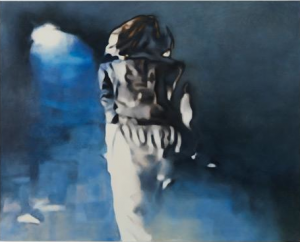
Painting and photography intertwine in this handsome if disparate show in which success hinges on how provocatively each artist elaborates upon her source material. Judith Eisler’s canvases of music or film stars seesaw between the bland and glorious, Mariah Robertson’s unique prints picture ambiguous spaces in eerily alluring color, while recent SVA grad Bryn McConnell limns vibrantly toned, if shallow, renditions of fashion spreads.
McConnell’s composition of a model draped over the edge of a bed is the show’s most attention-grabbing piece; its glowing orange and yellow highlights make Eisler’s two adjacent monochromatic paintings of Romy Schneider appear lackluster by comparison. Yet McConnell’s effort feels vacant, as she strips the identity of her subject—a model from a Miu Miu advertisement—reducing her to little more than a series of painterly strokes. Eisler, on the other hand, uses appropriated film stills to play up Schneider’s momentarily masculine look, nearly crushing her starlet charm. Similarly, in another nearby piece, Eisler seemingly morphs Deborah Harry into an astronaut by showing the singer as she retreats into a gorgeous blue shaft of light on a dark, smoky stage.
The artsy nudes and repeated palm motifs Robertson incorporates into her collagelike compositions look like borrowed stock photography, but they were actually created by the artist, who plays with photographic conventions. More pleasurable, though, are her purely aesthetic touches: horizontal bands of sunset colors, multiple images of an anonymous figure on a rooftop, and drip patterns, all creating an abstract scenario in which the imagination is set racing.
Originally published in Time Out New York, issue 777, August 19-25, 2010.
Martin Schoeller, “Female Bodybuilders” at Hasted Hunt Kraeutler

Can photos of babes in bikinis with big biceps be more than gratuitous? Martin Schoeller’s portraits of women bodybuilders pander to the inherent sensationalism of their topic, but also manage to transcend it, playing up deeply disconcerting contrasts between traits typically considered female (makeup, hair) and male (bulging muscles). He puts his subjects on pedestals as goddesses of discipline and self-control. By contrast, a second body of work largely deglamorizes the faces of celebrities who’ve agreed to pose for his flaw-baring lens.
In the former series, Schoeller magnifies his sitters’ bulk, framing them from the waist up in enormous 61.5″ x 50″ photos. The same women (e.g., Christine Roth, Carmella Cureton) appear on bodybuilding blogs and websites in more feminine—and, perhaps, objectifying—poses, but Schoeller’s gender-bending emphasis on pumped-up arms and abs showcases hard-won physiques that rebuff mainstream ideals of the female physique. Valerie Belin’s images of bodybuilders (who look so shiny as to seem practically chromed) come to mind, but Schoeller’s subjects are proud and unique.
In an ironic reversal, the best photos in the second series are of women with normal features and inflated personalities: an ethereal and unrecognizably dignified Paris Hilton; Sarah Palin, captured as a cipher constructed out of makeup. Most of these other portraits, however, are about as compelling as a driver’s-license picture. Marina Abramovic shows no trace of the pain and drive she’s poured into her career, while deadpan studies of Chris Rock and Jerry Seinfeld, clinical takes on Bill Murray and a dozy Kobe Bryant beg for something to make us take notice—be it brawn, beauty or brains.
Originally published in Time Out New York, issue 776, August 12-18, 2010.
Carol Bove, Sterling Ruby, Dana Schutz at Andrea Rosen Gallery

At first glance, the works of Carol Bove, Sterling Ruby and Dana Schutz wouldn’t seem to have much in common besides their creators’ hot-artist status. Yet an undercurrent of aggression unites their otherwise disparate efforts. Bove’s unusually severe sculptures, Ruby’s antiauthoritarian sculpture and painting, and Schutz’s gruesome canvases (including one showing a finger sliced in a fan) range from bold elegance to cheeky flipness in their flirtation with darkness.
Bove’s huge Plexiglas-and-expanded-sheet-metal boxes are the surprise of the show: a cold departure from her intimate assemblages of books and ephemera nostalgically evoking the ’60s and ’70s. The diamond-patterned mesh covering the top, bottom and sides of these rectangular objects explains the title, Harlequin, perhaps after Picasso’s predilection for that subject; here, they become obstreperous gatekeepers, obstructing access to the back galleries.
Bove’s works would have made an interesting match with Ruby’s creepy cage sculpture from his last solo show at Pace Gallery; instead, the latter is represented by the comparatively refined Consolidator, a dark-brown sculpture resembling a cross between a cannon and a coffin, whose title, scrawled across its face, exudes a vague corporate threat. A nearby painting references both a notorious nightclub and a supermax prison, starkly contrasting freedom with lockdown.
Lack of self-control afflicts Schutz’s hapless characters, which include an escape artist who’s pinned himself to a target with knives, and the numskull whose appliance-sliced finger has just generated a tasteful if gory modernist abstraction. After Bove’s monuments to the beauty of power and Ruby’s ominous embodiment of fear, Schutz’s tongue-in-cheek portrayals are laugh-out-loud funny, and the highlight of this show.
Originally published in Time Out New York, issue 775, August 5-11, 2010.
Tala Madani at Lombard-Freid Projects
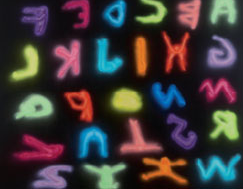
Tala Madani’s solo show offers relief from the aggressive nastiness of her sadistic characters and their hellish world but, while the mood shift is palpable, it’s still far from redemptive. Legions of tiny male nudes in neon colors on black canvas spelling out the letters of the alphabet are an irresistible lure. But when the letters form words and phrases like in Men R Hot with Fire (2010) (where the ‘t’ is depicted on fire) or in XO with Stripes (2010), they don’t communicate brotherly love. Dehumanized by lack of distinguishing characteristics and gruesome contortions, the characters are no longer perpetrators of abuse; instead, responsibility for their treatment lies with the artist.
Yet a stop-motion animation of a dancer — a standout from the show’s other violent videos — suggests that Madani’s inspiration comes in part from the human body’s astonishing range of movement. This injection of sincerity into Madani’s sinister world is counteracted by cautionary pieces like a giant composed of letters, Leviathan (2010), who hints at the abusive power of language; and an eye exam chart populated by human letters, Eye Exam (2009), which begs the question of what we really see in the world around us. Taking on communication itself as a subject matter, Madani keeps a critical eye while making a welcome break from the claustrophobic world of her past work, opening up promising new directions.
Originally published in Flash Art International, no 272, May/June 2010.
Trisha Donnelly at Casey Kaplan Gallery
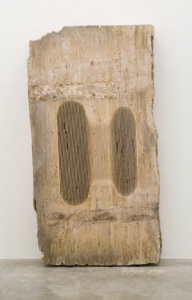
It says something when an artist can produce an exhibition of totally abstract artwork that runs the risk of being too obvious, but Trisha Donnelly’s latest solo show is almost unsettlingly easy to read. With no gallery statement and only one titled work, a few things are still left up in the air, but this show’s layout and content make for a pleasant, if straightforward, journey through the artist’s thought process.
A kidney-shaped desk (a found object) titled The Secretary, which greets visitors in front, seems at first uncomfortably obtuse, blocking access while posing the question of what we’re meant to glean from it. Only in the next room do its feminine curves make sense in comparison with a pretty pink marble sculpture, adorned with concave impressions that evoke breasts or eyes and appear to channel Brancusi. It seems we’ve stumbled on the secretary herself, a surprisingly primal creature, minimally altered from her natural state but with striking features nonetheless.
Such amusing opportunities for personification eventually peter out as Donnelly, who used a rotary saw to incise columnar and grille-like shapes into two sculptures, settles for the traditional role of mason. This suggests that while her contemporaries are content to dig into modernist history, Donnelly goes further back in time, mining raw material from the same earth as the ancients (the pieces are made out of limestone quarried in Bolzano, Italy). She calls to mind their labors while producing forms that resonate with contemporary life.
Originally published in Time Out New York, issue 769, June 24 – 30, 2010.
Patricia Esquivias at Murray Guy

Patricia Esquivias’s immediately likable narrator voice is the hook in her major new video,Folklore III, keeping us engaged through dull, repetitive images and the creeping suspicion that there is less to the historical connections she weaves between two lands—Galicia, Spain; and Nueva Galicia, Mexico—than her deadpan delivery suggests. Unsupported by video evidence, the details Esquivias describes—childlike decorations on the houses, a vast unfinished monument—gradually come to seem more fanciful than believable, and thus, wonderfully entertaining.
Old Galicia represents endings—we see scenes of the coastline and hear about the rituals enacted there—while new Galicia presumably offers a fresh start to immigrants. Yet it’s the Old World that hosts a peculiar and inherently hopeful architectural custom, whereby homeowners build successively larger floors onto their buildings, creating edifices shaped like inverted Aztec pyramids. Such optimism in the future contrasts with the stasis of Nueva Galicia, where newcomers never really find their feet, subtly upending the assumption that newer is always better.
The show’s second major piece, Natures at the Hand, (from 2006) reverses tactics by favoring visuals over story, though it continues to forge similarly tenuous historical or thematic connections—comparing topiary in European castles with that in Guadalajara’s front yards, for example. Collaging disparate images together to create new narratives is a common strategy these days (Fischli and Weiss and Fia Backström come to mind), but Esquivias makes the approach her own by delighting in the simple absurdities of life, and evoking a cross-border culture in which the fluidity of facts meets the charms of quirkiness.
Originally published in Time Out New York, issue 768, June 17-23, 2010.
Thomas Houseago at Michael Werner Gallery
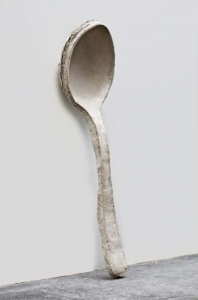
The sculptures in Thomas Houseago’s first New York solo show defy reigning art trends by embracing monumentality, mining art history for subject matter without being overacademic or self-conscious, and conveying meaning without detailed background info. None have the commanding presence or shape-shifting potential of the artist’s towering Baby, a standout in the current Whitney Biennial. But his totemic and iconic pieces, made with labored simplicity, plumb life’s mysteries with hopeful optimism.
A line of skulls just inside the gallery would be grim if not for their wealth of associations, from Darth Vader’s mask to Picasso’s haunting late self-portraits. Jonathan Meese’s Cubist-indebted faces come to mind, but Houseago’s heads are more in keeping with the simple, alien grotesquery of Ugo Rondinone’s all-black visages. With their hollow, zombie eyes, quizzical semi-squints and fingerlike ropes of flesh on their faces, the figures float between life and death, pop culture and high art.
The show itself ambitiously aims to be many things at once—figurative and abstract, humorous and serious, historical and contemporary—but it feels crowded and thematically discordant at times. It’s tempting to hunt for humanist metaphors to tie together pieces like the two giant spoons à la Claes Oldenburg (nourishment?) and the Brancusi-like totem with bird’s head/bike helmet on top (spirituality?). Other objects make more fruitful associations: A repeated circle pattern appearing in a ghoulish face, a geometric frieze, and a sculpture representing sunrise and sunset merges personal and cosmic concerns, connecting dark souls to shining celestial bodies—and speaking for art’s ability to enlighten.
Originally published in Time Out New York, issue 764, May 20 – 26, 2010.
The Bruce High Quality Foundation University at Susan Inglett Gallery
The concept behind the Bruce High Quality Foundation’s third New York solo show is more engaging than the artwork, which comes as no surprise. The anonymous artist collective’s move to start its own free, unaccredited school is a gutsy and overdue reaction against the pressure on artists to complete costly MFA programs. But just as student work generally hasn’t had time to mature, the sculpture created by the artists known as ‘the Bruces’ in response to the past semester’s discussions and plans for the future is more a collection of ideas than a profound statement.
Sculpture in the form of chalkboards summon the spirit of Beuys, while unusable desks fashioned from broken drywall resemble post-apocalypse Bauhaus furniture; neither looks meant to last. Literally erasable, the chalkboards epitomize the experimental, non-product-driven nature of the Bruces’ approach. Humor is rampant, from a blackboard reading ‘in the future everyone will be a foundation,’ a twist on Warhol’s famous 15-minute bon mot, to a study of art world gender disparity with a female superhero mask and hairdryer balancing a beer stein with a fake breast. Obviously, these artists are having a good time inspiring each other and now a larger audience of ‘university’ attendees. The resulting artwork may not stand the test of time, but it’s an enticing invitation to join the fun.
Originally published in Flash Art International, March – April, 2010.
John Bock at Anton Kern Gallery
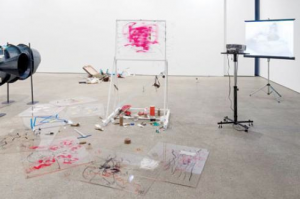
The remnants of John Bock’s current performance at Anton Kern Gallery—a floor littered with Plexiglas sheets covered in marker drawings, smiley-face stickers and sausage slices; a suitcase full of handmade, low-tech mechanisms—speak to the artist’s willingness to mine the ridiculous, grotesque and nonsensical in order to build fantastical, alternative realities. The new work, including two videos shot in Korea and a series of wall sculptures, offsets confusion with absurdity, striking an appealing balance between eccentricity and humor.
Bock’s videos feature an assortment of antiheroes who use a revolving lineup of devices to navigate unfamiliar terrain. The live performance distills this same sort of activity, via a hired dancer who tests a series of contraptions cobbled together from wood, stuffing and masking tape, as Bock diagrams his actions in rapid-fire sketches on Plexi. Like an artistic MacGyver, Bock’s resourcefulness in crafting, say, a sandbag-like weapon out of a pair of tights enables his characters to meet the challenges of an illogical world.
Just as performance partially decodes Bock’s frenetic, abstract diagrams, a mini horror movie, Büsche (Box), pokes fun at the psychological drama of a longer video titled Para-Schizo, ensnarled, in which two muttering loners employ totems and devices to walk, eat and engage in a destructive love affair. Their tools don’t fix anything: One character meets an abject death, the other finds a secluded peace, suggesting that while life may present us with obstacles, our efforts to overcome them—reasonably or not—are still valiant.
Originally published in Time Out New York, issue 756, March 25 – 31, 2010.
Steve Mumford at Postmasters
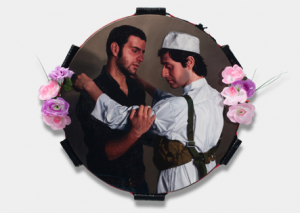
Steve Mumford may have taken six trips to Iraq in the past seven years, allowing his art practice to be absorbed by picturing the war there, but while his agenda remains curiously ambiguous, he clearly avoids propaganda. In a style inspired by the 19th century American Realist painters, he treats his subjects, from Iraqi prostitutes to Islamic leaders, U.S. soldiers to jihadist fighters with dignity regardless of their beliefs and dealings, a tactic bound to rile his various subjects, never mind his audience.
War is Mumford’s ostensible subject, but the people he depicts are in limbo, not action, putting the emphasis on their individual characters rather than symbolic identity. The prostitutes are modest and brave, huddling together in their black, one-piece swimsuits isolated at the center of an empty swimming pool; a jihadist pausing to write in a notebook on a rocky hillside commands respect as a thoughtful intellectual. Mumford’s paintings work both sides of the fence, eliciting sympathy for a beautiful U.S. soldier who lost her arm one minute, a male suicide bomber who bids a tearful goodbye the next.
Are terrorists worthy of compassion? Sympathy? Mumford shifts the decision to us, obscuring his point of view by framing the painting in cheesy fake flowers and explosives that diminish its sincerity. Likewise, there’s nothing straightforwardly heroic or the reverse in the appearance of U.S. troops skinny-dipping in a marsh, no uniforms hiding their unique complexions, builds and tattoos. Small text paintings inspired by bathroom graffiti in military camps round out the show, trafficking in disillusioned cliché and acting as foil to the nuances of the portraits that spare judgment and replace dogma with real people.
Originally published in Time Out New York, no 755, March 18-24, 2010.
Liam Gillick at Casey Kaplan Gallery
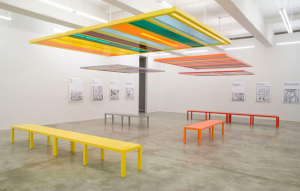
Liam Gillick’s sculpture, writing and design relate to architectural space, but rarely encourage us to inhabit it, making the seemingly simple addition of benches to his previously debuted overhead sculptures (titled ‘discussion platforms’) a profound development. In a video, Gillick advocates occupation of time, not space, as a means to bring about social change; paradoxically, the new sculpture seems to allow both and relies heavily on the artist’s habitual hope that simple objects will convey complex ideology.
Gillick would be the last artist to purposefully set up binary oppositions, but fundamental incongruities abound, as when the proximity of colorful sculpture makes ordinary benches look beautiful. In the video, we peer over the artist’s shoulder into the dual emptiness of his sterile workspace and his computer screen, where he manipulates an architectural drawing of a factory inspired by a Godard film. The accompanying jargon-filled soundtrack offers a flood of words from the ‘authoritative voice’ Gillick abhors and frustratingly resists any connection to the source material.
In the main gallery, a textual exchange between a quasi time traveler and a contemporary bartender paired with images from medieval woodcuts is more likely to catalyze Gillick’s audience with its provocative blur of time and place. Familiar and strange at the same time, the centuries-old scenes of labor and communal celebration are a puzzle and an exhortation to consider the leisure time we’re enjoying as we sit. Benches – perches of lovers, readers or the homeless – may be less the seats of power than tables or desks, but their identity as temporary resting places is a perfect fit for the in-and-out patterns of gallery visitors and the speculative nature of Gillick’s project.
Daido Moriyama at Luhring Augustine
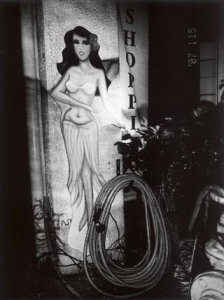
A lone, hunched figure—Van Gogh’s Sorrow draped in a beach towel—opens postwar Japanese photography legend Daido Moriyama’s show about Hawaii, but its brooding mood is misleading. In contrast to a selection of his photos from the ’70s and ’80s in the back gallery, Moriyama’s recent work is literally and figuratively lighter, departing from his trademark rough, blurred and out-of-focus style in a redemptively upbeat portrayal of the islands.
With refreshing honesty, Moriyama doesn’t pretend to be anything other than an outsider, sticking to themes of sun, sand and tourism. Apart from a few shots—weeds engulfing an abandoned car or a hula girl mural in a grubby yard—he’s less interested in exposing life behind the scenes than transforming stereotypical subject matter, which he does with mixed success. A grainy shot of fog rolling in over tropical vegetation and blurred images of palms are nothing new, but a fast-food joint made radically strange by dramatic sunlight or a still close-up of a highly erotic conch shell render the overly familiar strange.
Instead of mounting a critique of crass commercialism, Moriyama portrays tourists as intrinsic to or respectful of the landscape—a kid crawls turtlelike on the beach, and poncho-wearing lava watchers resemble pilgrims—while uncommonly pleasant tourist-shop mannequins portray commerce as low-key. Lest the series come across as too feel-good, Moriyama adds an excremental pile of lava here, a grotesque sunbather there. But with the exception of a kitschy image of a dog wearing sunglasses—a far cry from the artist’s iconic 1971 depiction of a menacing stray—the series’s positive tone is striking evidence of Moriyama’s sensitivity to Hawaii’s mutability.
Originally published in Time Out New York, no 753, March 4-10, 2010.
Virgil Marti at Elizabeth Dee Gallery
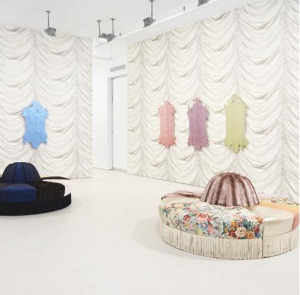
Virgil Marti threw a party, but no one showed up. Or so appears his latest decor-as-fine-art installation of wallpapers and furnishings. Chromed mirrors, and anthropomorphized home trappings claiming James Whistler and Chippendale as inspiration, drive home Marti’s recurring theme, that kitsch and excess are two sides of the same coin. But while his show perfectly sets the mood for a high-camp soiree, in the quietly trafficked gallery, it leaves the lingering impression that our invitations must have been lost in the mail.
Not many artists would represent their parents as settees upholstered in flowers, fur and gold lamé (for Mom) or deep blue with black polka dots rimmed in yellow accents (for Dad), as this one does. These fabulously eccentric character studies suggest that Marti is either the secret love child of Liz Taylor and Barry White, or he’s using liberal doses of artistic license to charming effect.
Unfortunately, the seats are off-limits according to a posted sign, sinking the possibility of an impromptu gathering or interaction with strangers. Granted, Marti’s work speaks to the history of objects, but relational aesthetics has us primed to enjoy a coffee and film à la Rirkrit Tiravanija. Frankly, this show could use a little of that, especially since references to role-play, social interaction and posturing seem to run throughout, from the swagged wallpaper (resembling the curtain of an opulent old theater or movie palace) to the hardwood patterns on the mirrors (a reference to treading the boards?). Sadly, allusions to socializing aren’t as compelling as the real thing.
Originally published in Time Out New York, issue 748, January 28 – February 3, 2010.
William Daniels, “Paintings” at Luhring Augustine
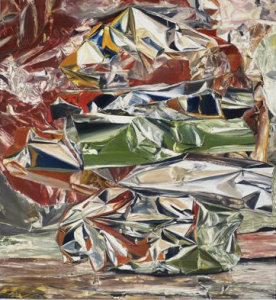
“I thought they’d be bigger!” exclaimed one visitor to William Daniels’s first New York solo show of oil-on-board paintings, none bigger than 13 inches square. In reproductions, Daniels’s images of angular metallic surfaces—mystery objects wrapped in aluminum foil situated within foil-covered sets—grab attention. In person, the seven tiny pieces dotting the walls of the main gallery convey a cheery yet shallow intimacy, evoking shiny candy wrappers or Christmas lights glinting off an ornament.
Despite the bonhomie of pretty hues, Daniels’s subject matter is monotonous, and seesaws between superrealism and lyrical license—a style that’s especially frustrating when the objects are hard to distinguish from their backgrounds and merge into shallow planes of crinkly foil. Eschewing the temptation to depict people or things in reflection—à la Jan van Eyck’s The Arnolfini Wedding, for example—Daniels rejects references to the outside world, creating little hermetic dioramas of light and color, calculated to break boundaries between abstraction and representation, painting and sculpture, by being all at once.
Undoubtedly, this show proves Daniels’s painterly ability and experimental creativity. But unlike his previous meticulously painted reproductions of torn-paper collages sending up or paying homage to canonical art-historical images, the latest work is, unfortunately, literally reflective, and not metaphorically so. The foil covered objects recall John Chamberlain’s twisted auto parts without their bravado, or James Rosenquist’s chrome panels segueing into spaghetti minus the subject matter. Ultimately, while Daniels’s paintings connect with the contemporary fashion for antimonumentality, they have disappointingly little to say.
Originally published in Time Out New York, issue 748, January 28 – February 3, 2010.
Janine Antoni, “Up Against” at Luhring Augustine
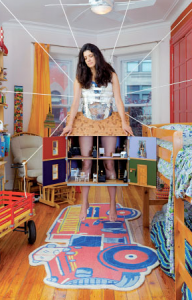
Tied together only by an amazingly adaptable title, Janine Antoni’s new photography, sculpture and installation leap from theme to theme — new motherhood, Hurricane Katrina, a cheeky re-imagining of the female anatomy — in an ad hoc exploration of intimacy and/ or adversity. Though some of her best-known artwork has delved into her relationship with her mother, Antoni is frustratingly ambivalent about her own connection with her young daughter. Ironically, it’s when Antoni herself seems to be acting juvenile, in a piece that has her urinating from the top of the Chrysler Building, that her work is most resonant.
At the gallery entrance, a photo of Antoni’s toddler poking a spoon at her mother’s exposed navel portrays the artist as authority figure, so it’s startling to encounter an image of her using a bronze, shoehorn-shaped gargoyle as a substitute penis to direct a stream of urine in a hilarious piss take of the adolescent male urge to mark territory. Less daring than Margaret Bourke-White’s famous perch atop the Chrysler’s eagles, more restrained than Lynda Benglis’s raunchy posturing, Antoni’s absurd gesture is nevertheless empowering, removing one more obstacle between the sexes.
The show’s final two pieces are less original. A damaged wrecking ball coupled with a close-up projection of an eyeball blinking to resounding booms is a one-dimensional parable of destruction in the blink of an eye and too closely tied to the context of its debut at “Prospect 1” in New Orleans. In a final photo collage, Antoni hovers, spider-like, from a rope web wearing a doll house as skirt, her flesh filling rooms and pressing against tiny furniture in a beautifully succinct illustration of motherly overbearing. But it’s not clear what Antoni’s getting at with the spider reference (and hard not to compare with Louise Bourgeois’s powerful Maman), while the martyr-like pose she strikes doesn’t say anything new about mothers’ sacrifice. We’re extended a tantalizing invitation into the intimacy of her personal experience but come away unenlightened.
Originally published in Flash Art International, no 267, November – December 2009.
Walid Raad, “Scratching on Things I Could Disavow” at Paula Cooper Gallery
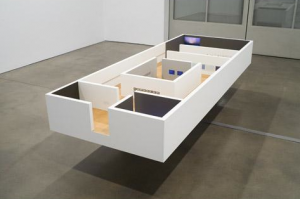
The Arab world has recently jumped on the global art bandwagon with a spate of new fairs, biennials and galleries, but Walid Raad is less than enthusiastic. His jam-packed résumé makes him an unlikely candidate to critique the forces of globalization, but surprisingly, this show of new sculpture and work on paper—subtitled “A History of Art in the Arab World/Part I_Volume 1_Chapter 1 (Beirut: 1992–2005)”—cynically argues the powerlessness and conflicted interests of artists.
In text accompanying a sculpture of a miniature exhibition space installed with pint-size versions of his work, Raad asserts that his entire oeuvre mysteriously shrank the moment he agreed to show it in his vast Beirut gallery. The premise is absurd, but the message cautionary: Participation in the system comes at the cost of meaning.
Artists are bypassed as active parties in the exhibit’s two other main pieces. A wall text and photo essay are based on telepathic communication from misguided future artists, who long for an authoritative, editing hand. Elsewhere, a collection of pages from various publications purports to demonstrate the fanciful notion that during the Lebanese wars, compositional elements—color, line, shape—became refugees, hiding in the text and format of various documents and ephemera.
Raad’s critiques are so tangential, his story lines so elaborate, that he doesn’t quite get around to concrete hypotheses on how conflict shapes aesthetics. But if his own resistance is a catalyst for other artists to ignite a new flurry of art activity, one couldn’t hope for more.
Originally published in Time Out New York, issue 740, December 3-9, 2009.
Nick Mauss at 303 Gallery
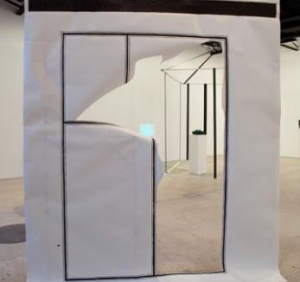
For his first solo show at 303, Nick Mauss takes a decisive step away from his best-known earlier work—paintings of dandyish figures adrift in lush fields of color—with minimalist sculpture and stark, etchinglike compositions on silver leaf. Somewhere between an attack on history and self-editing in overdrive, the work makes explicit the frustrations involved in the impulse to communicate.
Though his approach is nearly abstract, Mauss takes pains to invite viewers into his universe. A huge sheet of paper hung to suggest a doorway, then torn open, stands near the gallery entrance, ushering us into the show. Beyond it, a house-shaped framework suspended from the ceiling surrounds a slide projector showing blank slides, continuing the metaphor for transparency but literally and conceptually offering little substance.
Both feel like mere stage setting for the panels, rife with subject matter yielded grudgingly. Because the works are positioned at awkward viewing heights against the gallery wall, it’s easy to miss the occasional vessels, mythological characters or beasts that remain after the artist distressed the surface to reveal a void of black paint under the silver leaf. The vigorous scratch patterns nearly obliterate the sketchy figures, evoking an aura of vandalized archaeological treasures. This subtle attack on icons of ancient art history also recalls Rauschenberg’s erased De Kooning drawing, but Mauss’ idiosyncratic selection of subjects suggests something more personal, like burning a diary or sketchbook. While he doesn’t always strike a proper balance between emulating the past and wanting to eradicate it, his bold marks on delicate panels are an admirably decisive act.
Originally published in Time Out New York, issue 739, November 26 – December 2, 2009.
Jessica Stockholder, “Flooded Chambers Maid” at Madison Square Park

Jessica Stockholder’s synthetic aesthetic is a strange fit for the beautifully planted Madison Square Park, and her first outdoor installation was a confusing mix of resistance and concessions made to its setting. The alien, saturated colors of a seating platform and set of bleachers took little inspiration from their verdant surroundings. Yet to make this durable furniture for park users, she disappointingly abandoned the improvisatory quality that makes her work so rich. True to Stockholder’s practice of experimenting with unconventional materials, she also created a design in greenery and colorful plastics, but the result is as disjointed and uncommunicative as the installation as a whole.
Among the characteristic sculptures of repurposed consumer goods in her concurrent gallery show at Mitchell-Innes & Nash, a standout assemblage resembled a matronly figure standing before orbs of light on a lawn-like base, making a clever connection between inside and out. But instead of taking the next step and actually engaging the natural world in the outdoor installation, the piece looks ill at ease, its colors and geometries relating less to the park itself than the man-made objects and structures visible on its perimeter.
In what should have been the installation’s focal point, but which was instead a segment of the show half-hidden behind the bleachers, Stockholder attempted a literal combination of nature and culture with a winsome, asymmetrical arrangement of grasses and flowers alongside a too-sparse scattering of man-made materials. The myriad associations that Stockholder can evoke with everyday objects makes her practice compelling; but the banality of this planting suggests we have a more developed relationship with our most commonplace, manufactured junk than with the products of nature. Stockholder’s outdoor debut can leave one wanting to see the artist get back indoors to her studio.
Originally published in Flash Art International, no 268, October 2009.
Sarah Anne Johnson, “House on Fire” at Julie Saul Gallery
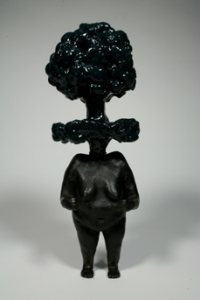
There are gaping holes in the shocking story told by Sarah Anne Johnson’s latest sculptures and drawings done on old photos, but the omissions speak volumes. Filtered through the artist’s own childhood memories, as well as first- and secondhand accounts, Johnson revisits the harrowing experience of her late grandmother, Velma Orlikow—one of a group of unwitting patients under the care of a CIA-funded psychiatrist who experimented with brainwashing techniques. Orlikow was subjected to various shock and drug therapies, as well as bouts of prolonged, medically induced sleep. If such a tale can have a lighter side, Johnson looks for it, while also conveying the shattering effects of Orlikow’s ordeal.
Orlikow, who’d originally sought treatment for postpartum depression, plays a starring role in the work, while Johnson’s mother remains an enigma, prompting the question of how the trauma might have passed down through the family. It’s also dubious how Johnson could find a comic element in her grandma’s situation, offering diminutive nude sculptures that depict her with a squirrel’s head or a nuclear cloud blossoming from her skull. (Did Orlikow herself have a sense of humor about what happened?)
Yet an elaborate doll house, which could have been the show’s most lighthearted component, gives sobering insight into Orlikow’s psychological hell, with its hallway going nowhere, foyer under water and melting kitchen walls. While her daughter and husband sleep, Johnson’s grandmother is shown dancing nude in the attic with her doctor, suggesting her sense of vulnerability.
Eventually, Orlikow gave her testimony during a class-action suit that ended in a settlement. Johnson succeeds in adding feeling to those facts with stunning glimpses into the depths of her grandmother’s suffering.
Originally published in Time Out New York, issue 734, October 22-28, 2009.
Alessandro Pessoli at Anton Kern Gallery
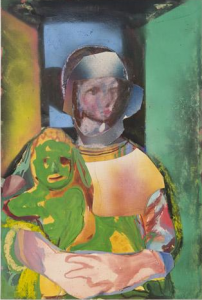
Though ubiquitous in art history, Christ rarely makes an appearance in Chelsea, meaning that Alessandro Pessoli’s recent paintings of him are surprising for their subject matter alone, not just Jesus haunting weakness. A standoff between a glowing crucifixion at one end of the gallery and a crude portrait of an unruly boy flexing his muscles in mockery at the other sets the scene for a clash between man and God. But the show gets mired in a stumbling uncertainty that there’s any difference between divine and mortal characters.
Pessoli reinvents Christ’s suffering with idiosyncratic symbolism: a body flayed pink or burnt red and a prosthetic arm bearing sunny-colored but sour lemons reinvigorate his identity as the man of sorrows. Pessoli’s indistinct style perfectly captures Christ’s unknowable depth of loss and pain, though certain details—fat, clownish tears; huge, mouselike ears—recall George Condo’s buffoonish caricatures of the Almighty. Pessoli’s portraits aren’t irreverent, however; they afford Christ dignity, just not majesty.
Judging from the show’s other centerpiece—a pessimistic portrait of humanity as presented in a series of small painted sketches—the artist similarly fails to exult God’s crowning creation. Despite being interspersed with panels of gold textile suggesting icons, ghoulish characters with exaggerated features often appear alongside—and overpower—other, more innocuous images of a family, a musician and a runner to create a picture of a corrupt mankind. Paint-encrusted scraps of cloth Pessoli used to clean his brushes accent these vignettes, implying that humans are not the apogee but the castoffs of God’s process. The artist prompts an insincere question: If creation is badly made, who’s to blame?
Originally published in Time Out New York, issue 732, October 8 – 14, 2009.
Phil Collins, When slaves love each other at Tanya Bonakdar
Phil Collins’ ability to find entertainment value in social conflict is stronger than ever in his third New York solo exhibition, in which a soap opera and amateur snapshots become lowbrow delivery mechanisms for universal truths.Soy mi madre, a telenovela-style tale of class struggle steals the show, while a subtler, voyeuristic installation of amateur photos shot by residents of several European cities is a low-key paean to everyday life.Melodrama contrasts the mundane, but each elaborates convincingly on the complexities of human relations.
Soy mi Madre is a tour de force of upper class dysfunction and working class resentment, featuring a pampered lady of the house whose hilariously quick and frequent mood swings are matched by rapid-fire clichés that paint her husband as a lecherous alcoholic and her as mentally fragile, cold and ruthless.By the end, a pistol-wielding servant declares the house’s social order irrevocably changed and one wonders if this video, commissioned by Aspen Art Museum to broaden an audience that includes the area’s immigrant workforce, has the power to alter real life labor relations in ritzy Aspen or beyond.
Free Photolab, a slide projection of selected images by amateur 35mm film users who gave Collins the rights to their images in exchange for free processing, involves exploitation of a softer sort.As photojournalism by proxy, the project provides cheap source material for Collins and more than a few gratuitous glimpses of oddballs or exhibitionists for us.But the collective result – mostly portraits of friends and family at special occasions – has an eerie familiarity echoing common experiences and recalling Nan Goldin’s intimacy, Juergen Teller’s seediness, and Jamel Shabazz’s sassy posers.Several consecutive slides present jarring contrasts (a pregnant belly, then a funeral) but the pictures’ surprising strength is in their poignant take on universal experience.
Originally published in Flash Art International, no 267, July – September, 2009.
“The Generational: Younger Than Jesus” at The New Museum
Auction houses are gravitating towards mature artists and critics have sounded the death knell for the ‘young art star,’ but the New Museum’s first triennial still carries the torch for youth with its showcase of work by fifty international artists, all thirty-three years young or less. If this extravaganza of newness suddenly seems a little out of touch, the show’s curators insist that they’re following the lead of sociologists and marketers in examining the Millennial identity, intending to show it as a generation of producers, not just the consumers they’re made out to be. It falls to one of the generation’s own to honestly portray his contemporaries as consumable; Matt Keegan’s year-book style photo portraits of recent college grads, fresh faced and earnest, tellingly point out that their lives are, as of yet, still largely unlived.
Perhaps that’s why, despite input from fifty artistic voices, the generation’s defining characteristics stay hazy, regardless of the curators’ anthropological efforts. Artists like Liu Chuang get in on the investigation with a creepy, clinically neat display of personal effects he purchased from unknown women on the street. Fellow Chinese artist Chu Yun takes a reverse approach, inviting women to sleep in a bed in the gallery, presenting us with a person but no information on who she might be. Ryan Gander’s blood-flecked white tracksuit worn by one of the museum’s guards is one of the show’s best pieces, primarily because it creates a compelling, if fictional, identity for its wearer.
The show’s two most ambitious, riveting and unsettling works loosely relate to what the Millennial dossier does make clear: that the under-thirty population around the world is booming and its perception of social relations has been radically altered by the Internet. Cyprien Gaillard’s video of two large rival gangs in a sprawling, organized fight amid Soviet-era high-rises taps into fears of a generation out of control. Less alarming but no less alienating, Ryan Trecartin’s two-room bachelor(ette) pad is an eccentric setting for fast-paced videos in which zany characters act out personal dramas in a world of their own.
Josh Smith’s hastily produced, collaged abstractions are a painterly version of this overdrive, though their installation in a huge, pretty grid neuters their disregard for art making tradition. Appropriation and recycling also plays into Elad Lassry’s whimsical, ad-inspired images that evoke Sara van der Beek’s carefully constructed setups and Roe Ethridge’s mood-creating series but with more humor. Cory Arcangel’s gorgeous, fakey cyan abstraction (a default pattern from Photoshop) resonates with Tauba Auerbach’s process driven paintings, which recall Liz Deschenes’ op art patterns and Eileen Quinlan’s abstract setups in their adherence to a set of parameters established by the artist.
But the Generational isn’t the context for artists who are in conversation with their slightly older peers and its homogenizing approach to art from around the world assumes a global, artistic lingua franca, devoid of contextual details, that probably doesn’t exist. Several works echo better known artwork or familiar ideas, they appear to be fragments of a more complex practice, or simply beg the question of why they’ve been chosen to represent a generation. The show’s premise is more compelling than its content, its flip title promising big ideas that the artists themselves don’t even aim to produce. In a recorded introduction to the show, one of its curators says that today’s super-abundance of art product forces a redefinition of ‘new,’ though it may be better to ask if we should continue to expect the youngest artists to be the chief suppliers of ‘newness’ or original artwork in tune with contemporary life. Because to judge by this show, art’s obsession with youth is past its prime.
Scott Reeder, “Painter” at Daniel Reich Gallery
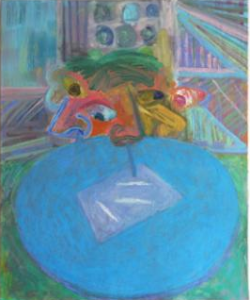
Last spring’s late-Picasso blockbuster at Gagosian Gallery posited the nonagenarian as a potential role model for young artists today, a suggestion only partially rebuked by Scott Reeder. Reeder likewise takes sex and death as themes, but while Picasso raged, Reeder cracks jokes. With his characteristic slacker painting style and irreverent humor, Reeder’s work demonstrates just how wide the gap is between the 20th-century canon and the contemporary artists who appropriate it.
To his credit, Reeder isn’t anxious at all about the influence of modernism: His transformations of the subjects of classic Cubist portraits into coke whores, for instance, are funny. (After all, what are all those noses good for?) But while Duchamp’s addition of a mustache to the Mona Lisa was a groundbreaking act of cheek, Reeder’s alteration of Duchamp’s Nude Descending a Staircase into Cops Ascending Staircase seems like a cheap knockoff.
The entire show feels saddled with a pre-recessionary tone of sex and binge drinking, though Nickel & Dime (End of the World)—showing the two coins flanking a mushroom cloud—does convey an ominous vibe in keeping with the current economic meltdown. Still, if Reeder’s images illustrate anything, it’s that the more things change, the more they stay the same. Basically superficial, sometimes juvenile, Reeder’s paintings refuse to take life or art too seriously, which may limit their staying power, but makes for an entertaining show.
Originally published in Time Out New York, issue 725, August 20-26, 2009.
Paula Hayes Installation at Marianne Boesky Gallery
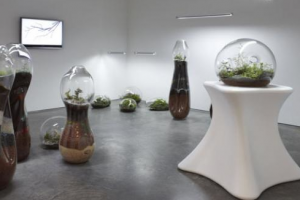
The abundantly planted new High Line, a hydroponic vegetable garden in Eyebeam’s windows, and now landscape designer/sculptor Paula Hayes’ terrariums and rooftop plantings testify that in Chelsea, green is the new black.Though Hayes’ resume includes gardens for prominent dealers and collectors, giving her plenty of art world cred, her work appears as much on terraces as galleries, and her primary media are plants and pots, begging the question of how vegetation becomes art.
Gardening has figured in the work of artists from Monet to Carsten Holler, but Hayes’ natural arrangements are an end in themselves.In undulating glass vessels roughly pedestal height, collections of tiny plants present nature as luxury object.Tiny succulents, or the fronds of a mini-fern are exquisite – a kind of maison du chocolate for greenery.Add the thrill of behind-the-scenes access to the gallery’s private rooftop installation, and taking in Hayes’ work can be a heady experience, inspiring wonder at the natural world and our ability to create beauty.
Unfortunately, Hayes doesn’t allow her terrariums and sculptures to stand on their own, introducing a thin storyline about a quasi-human gardener.On the roof, superabundant white sticks and a scattering of blue stones try for magical but come across as tacky.Part of the intrigue of Hayes project is the contrast between her organic-shaped planters and their glaringly synthetic materials – think of a small tree wearing a big blue sock over its roots.Such connections between plants and people – also evident in upright, body-shaped terrariums, or living, plant ‘necklaces’ – turn gardening from hobby to art form.
Originally published in Time Out New York, issue 722, July 30 – August 5, 2009.
“The Female Gaze: Women Look at Women” at Cheim and Read
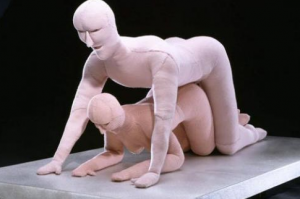
What is the ‘female gaze?’According to this show, it’s a category as wide-ranging as it sounds, running the gamut from riotous to reserved, racy to prim.In forty-one paintings, photographs and sculptures of female subjects by female artists, we’re repeated faced women demurely averting their eyes, but also find ourselves the objects of scrutiny by stony-faced characters.
In the front gallery, Diane Arbus and Julia Margaret Cameron promote voyeurism through their choice of subject matter.The former offers up a delectable young blond; Cameron, on the other hand, presents the quintessential ‘still waters run deep’ romantic type.Cindy Sherman skillfully mimics the slightly dopey Cameron look in her self-portrait, making her wistful character appear bland.
A graphic sex scene by Joan Semmel, rendered in lurid purples and pinks, is joined by a soft focus Lisa Yuskavage playmate and a coupling couple by Louise Bourgeois –all boisterously embodying the main gallery’s theme of pleasure in looking and being looked at.Pleasure meets pain in sexually derogatory texts presented by Jenny Holzer and Marina Abramovic’s self-abuse by hairbrush.The variety of approaches in this smart show, ripe with formal and conceptual connections, reinforce the idea that there’s no such thing as detached viewing.
Violet Hopkins at Foxy Production
Violet Hopkins‘ latest paintings won’t blow your mind, but her subject matter might. A hand holding a frog, a spiraling shell and more seemingly random subjects are actually based on photographs encoded on a solid-gold laser disc sent into space aboard on the 1977 Voyager mission as a primer to life on Earth for anyone out there who might be interested. Thirty years on, with interest in aliens confined mostly to the movies and economic concerns trumping the cosmos, Hopkin’s project neatly summarizes the current national psyche while posing the question of how one would create such a summary today.
With their fuzzy photorealism and drab palette, Hopkin’s small ink and pencil paintings redirect attention from themselves to Voyager’s impossibly ambitious aim of depicting everyone and everyplace. The show’s two largest works acknowledge the daunting nature of the task: A close-up of an eye reflecting a solar eclipse represents a quintessentially awesome experience which should actually blind its subject, while a rendering of the instructional diagram inscribed on the golden record looks undecipherable. The landscapes and portraits in the show, along with two ‘indexes’ – gridded images showing the vast variety of human achievement – would be of little use to E.T., but are uncomfortably revealing nonetheless, especially in our security-conscious times.
While the country may be more inwardly focused now than three decades ago, Hopkins, at least, gives us a chuckle with one image here of a groovy 70s landscape painter working in his chalet-style studio. Dated stereotypes aside, her project acknowledges art’s challenge to interact with a vast, ever-changing world.
Lara Schnitger at Anton Kern Gallery
It’s understandable that Lara Schnitger would want to move on after a decade of making her signature anthropomorphic bundles of wood and fabric. Too bad the three new sculptures in her latest solo show outshine the main offering, a series of lackluster fabric-on-canvas “paintings.” Wittily evoking recognizable character types like a glitzy matron or glamorous belle of the ball, the sculptures are suggestive and humorous while the paintings rely too heavily on contrasting patterns and colors.
Not that Schnitger’s use of materials is unappealing, as attested to by one arresting portrait of a mother with a glowing mass of orange hair and a nude body rendered in crags of bleached black fabric. Elsewhere, a stately Morticia Addams type flashes a leg from beneath a black, lace-stenciled dress while almost incidentally holding a tiny baby. Neither piece packs the punch of Schnitger’s earlier photocollages of babies with porn actresses, nor makes substantial comment on sexuality and motherhood.
Gratuitously erotic images—a bottom in the air, an anorexic onanist—and darkly symbolic pairings of women with cats or a crow have purely aesthetic purpose, though a more ambitious, bestial remake of Bronzino’s racy ‘An Allegory with Venus and Cupid’ avoids the anonymity of the other paintings’ mask-faced characters.
By contrast, Schnitger’s wry sculptural figures are the life of the party: A pointy armature on a pedestal becomes a big-busted grande dame in a gaudy getup, a skinny character in lingerie seems to trip over her own kinky outfit, and a stork-legged starlet struts in stilettos and a magnificently gaudy ball gown.
Mickalene Thomas at Lehmann Maupin Gallery
Can an artist use rhinestones and still be taken seriously? At first glance, Mickalene Thomas’s sparkly portraits of provocatively posed models hardly seem destined for the art-historical canon. But beyond the gaudy veneer, her paintings and videos empower their subjects—Middle-aged African-American women with different body types but a uniformly charismatic appeal—making this artist’s long-awaited New York solo-show debut uncommonly upbeat and inspiring.
In the front gallery, Thomas creates a minicatalog of inherited (and subverted) possibilities for expressing female identity, including an odalisque decidedly more modest and less youthful than Manet’s, minus the African servant. A huge grid of headshots recalls the look of Warhol’s photo-booth portraits but not their chilly mood. When they pull thoughtful poses or throw their heads back in laughter, Thomas’s models imitate the predictable conventions of music industry portraiture, but at least their pleasure is infectious.
This is even truer in three videos in the back gallery, shot at photo sessions that Thomas uses to create source material for her paintings. Fran is tickled by her own cheesy poses, while Sandra (the artist’s mother) flirts with a Robert Melee–style “eccentric mom” moment by donning a hideous dress and looking sour, until finally cracking a big grin. Shown in slow motion, sometimes with the camera tilted disorientingly, the models are objectified, especially the awesomely curvaceous Keri. But Thomas doesn’t make much of this or try to check our impulse to assume we know her subjects because we enjoy their pleasure in posing. Instead, the takeaway is a celebration of unconventional beauty that’s hard not to appreciate.
Sophie Calle at Paula Cooper Gallery
Casanovas, do not visit this show. In a juicy new twist on Sophie Calle’s practice of turning her private life into art, the artist invited 107 professional women, from a French intelligence officer to a Talmudic scholar, to respond to a Dear John e-mail she received. Predictably, the resulting dossier in text, photography and video pours scorn on the boyfriend while lavishing Calle with sympathy. But unlike the cringe-worthy wallow in self-pity that was her last show, Calle manages to turn her experience universal, making her project uplifting and entertaining.
Assembling a wide array of opinion on a document of consequence to only two people seems indulgent, but has a quixotic charm. Ironically, its also stymies understanding if you don’t read French, the language of most of the responses. However, given that the show also includes versions of the breakup e-mail in Latin and bar code, Calle may be hinting at a fundamental inability to communicate between her and her ex-lover, or between the sexes. The best responses—from dancers, a sharpshooter, even a parrot who rips up a little replica letter—are forceful with no words at all.
The show’s sense of feel-good, sisterly camaraderie is slightly soured by Calle’s disingenuousness: The break-up letter suggests that the relationship had been short and that both the artist and her boyfriend had continued to see old flames. But the concern that Calle’s responders show her—as when a sexologist gently discourages antidepressants or a clown sticks up for Calle—reinforces the show’s overall message that support is out there, and life goes on
Walead Beshty, “Popular Mechanics” at Wallspace
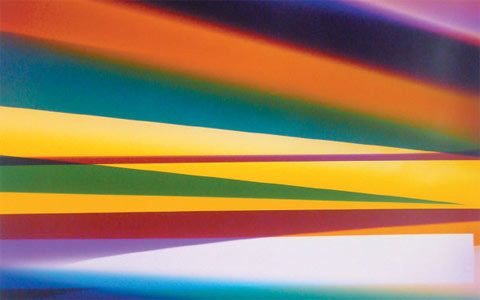
Walead Beshty’s gorgeous new color photograms are the star attraction of his third New York solo show . Yet the artist deliberately endangers their appeal by also exhibiting smaller, drabber, black-and-white depicting the machines that produced them, along with the curators, gallerists and other intermediaries who helped in their realization. In spite of Beshty’s best efforts to expose these energetic abstractions as mere commodities in a decidedly unglamorous chain of distribution, their aura remains undiminished.
As in previous photogram series, in which, for example, Beshty folded sheets of photo paper into freestanding sculptures before exposing them to light, these new images are made within certain parameters, this time involving the use of magnets and rolling techniques. It’s still unclear why Beshty has juxtaposed them with other images that are so different is size, color and mood. To do penance for dallying with pretty pictures? To draw some sort of parallel between the mechanics of the darkroom and art market?
The anthropological quality of the black-and-white portraits, which are titled not by a subject’s name but by his or her job description and nationality, along with the place and date of the photo, stands in cold contrast to the warmth of the almost glowing photograms. Maybe next time Beshty could relegate process to the background, and allow the artwork to take center stage.
Jessica Rankin at The Project
The embroideries, drawings and watercolors in Jessica Rankin’s latest solo show, while serene on the surface, hide tumultuous thoughts. On panels of organdy, she’s stitched provocative textual fragments from a Babylonian creation myth, along with diaristic phrases from other sources, which together present a picture of celestial failings and human weakness. Beautiful yet restrained, the contrast between content and delivery is both provocative and puzzling.
A gorgeous image of a shimmering moon in the first gallery introduces the show’s loose theme: Aspects of nature can act as metaphors for human misunderstandings. Titled Termagant, the piece has two referents (an old Western notion of the Muslim god’s identity and a quarrelsome woman) that, while unrelated, both sprang from failed communication between individuals or groups. In another panel, lines of text form concrete poetry, resembling the crags of mountaintops, though phrases relating to a blank night or weak body suggest a similarly rocky psychic terrain. Similarly, the profound pessimism in the texts that describe Babylonian immortals—a mother who loathes her children, a father overly proud of his son—read like a lament for a prelapsarian time that never was.
Comparing ancient times to present-day experience is fertile territory, but not one that Rankin explores deeply and the meaning of these semiabstract images remains as ephemeral as the fabric they’re sewn on. Rankin seems to like it that way, though she runs the risk that, consequently, our memory of this show will be equally fleeting.
Paul Morrison at Cheim and Read

Flower painting may have sustained two centuries of Dutch artists, but Paul Morrison’s latest solo show suggests he’s maxed out on the genre. After a decade of producing black-and-white landscapes dominated by schematically rendered flora, Morrison has decided to add figures and a splash of gold leaf. Still, like his repertoire of cartoony dandelions and mushroomlike trees, the new material doesn’t communicate much beyond a noirish mood.
One of the show’s best pieces crowds a 19th-century Alice in Wonderland look-alike, a giant Disneyfied daisy and something suggesting an exploding pinecone into a small canvas with dizzying, psychedelic effect. Similarly, a work featuring the moon’s reflection in water, morphing into a sinister ghost, makes for a striking design. But the human subjects in two other paintings—a young Elizabethan noblewoman in a Bambi-esque woodland, and a pouty top-hatted schoolgirl in profile set against bleak pines—are just stand-ins for their floral counterparts.
The girls’ anonymity and their fakey surroundings don’t reward speculation about who they are or what they represent. Unlike Walton Ford, whose meticulous renderings of the animal kingdom reveal as much about human attitudes as animal life, Morrison’s conceptual gambit stops at juxtaposing historical and contemporary images of nature, while throwing in evocative but unrelated titles culled from botanical terminology. Allusions to the subjectivity of taste—exemplified by two huge,elegant dandelion sculptures in the show—are so common in contemporary art that Morrison’s next move will have to be more radical to be relevant.
Originally published in Time Out New York, March 12 – 18, 2009.
Erik Lindman, “House Wine, House Music” at V&A Gallery
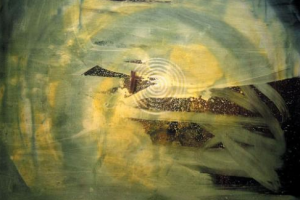
Erik Lindman can’t make up his mind to play it straight as an abstract painter or follow a conceptual path. And who can blame him? At age 23, he still has time to mull things over, though three moody canvases in his gallery debut are a cut above the other ephemeral objects on display. Colorful and complex, they’re enough to add him to a growing cadre of young painters reinvigorating abstraction.
A small photo—of a storefront window covered with torn notices and paint smudges—is the show’s Rosetta stone, directing viewers to look for evidence that the paintings were also added to over time. Lindman pays homage to those who came before him (Pat Steir, Jasper Johns), but he’s so intent on leaving traces of the significant labor put into each canvas that they’re in danger of looking overly manipulated.
Lindman’s inspirations are interior and graphic design, and while he’s careful to mask them, at least one add-on to the show tips his hand: A curvy wicker stool sitting before a painting in which the combination of circular motif with green-yellow haze creates a sense of intrigue. In the best piece, an expanse of ugly brown gives way to a triangular, rippled pattern of color, as if a subway poster had been torn away to reveal what was underneath. Rich with association, Lindman’s paintings don’t need their sources to be spelled out. They allow the pleasure of looking to be the final word.
Originally published in Time Out New York, February 26 – March 4, 2009.
Cindy Sherman at Metro Pictures
Metro Pictures Nov-Dec 2008.
Cindy Sherman dresses for success, donning a range of disguises that masterfully evoke the absurdity of the 'too much money, too little taste' crowd.
Kate Clark, ‘Perfect Strangers’ at Claire Oliver
Kate Clark makes stand-alone sculptures that look like they belong in a fairy-tale.
Olaf Breuning, at Metro Pictures
Olaf Breuning turns serious issues into a laughing matter.
Zhang Huan, “Blessings” at PaceWildenstein Gallery
After he moved to Shanghai from New York in 2005, Chinese art star Zhang Huan hired a huge staff to man a factory-like studio; the enormous installations that fill PaceWildenstein’s two downtown galleries give ample evidence of the scale of his industry since. But the new work lacks Zhang’s signature risk-taking, making it feel safe, easy to consume—and fashionably “Chinese.”
The show’s centerpiece, a nearly 60-foot-long “painting,” is as interesting for the technique used to create it (carefully spread ash from burnt temple offerings) as for what it depicts: an ambitious Mao-era canal project with potential correlations to ambitious contemporary undertakings such as China’s massive Three Gorges Dam. Zhang’s recycling is also conceptually engaging—using highly symbolic spent materials to create something new, which, in turn, refers to the past. But in light of the artist’s past performance-art pieces, for which he coated himself in fish, oil and honey in a public latrine, or donned a “muscle” suit made of raw meat, the ash paintings lack any sense of transgression.
Likewise, a series of “Memory Doors”—intricate carvings made over historical photos adhered to ancient wooden doors—are beautifully crafted, but their subject matter (peddlers overloaded with wares, farmers loading a truck) is more illustrative of China’s shifting economy than particularly illuminating in an art sense. Ironically, the show’s most ambiguous piece—a pregnant giant, covered by animal hides and slumped as if heavily burdened—might symbolize China’s imperiled natural world, but it could also stand in for the unfortunate taming of one of China’s most provocative artists.
Delia Brown, “Precious” at D’Amelio Terras
Delia Brown paints subjects we love to hate. In the past, she’s depicted herself and her friends in a manner blatantly intended to arouse jealousy—flaunting their youth, sexiness and supposed wealth. Her latest series still unfolds amid the trappings of (borrowed) luxury, but adds cute kids as props in saccharine portraits of the artist and other women (none of whom have children, according to the gallery statement) playing happy mom. As tidy and controlled as her earlier scenes were louche, Brown’s vision of motherhood is as irritatingly unrealistic as it is incisive in exposing unattainable ideals.
Brown has claimed Mary Cassatt as an influence, but even Cassatt occasionally pictured a feeding or diaper change, labors that Brown ignores. Instead, cooperative children are seen lounging with carefully preened moms on cozy beds or couches in immaculate homes; it’s unclear whether the little darlings are “precious” for being themselves or for serving as must-have possessions.
Brown may have intended some sort of meditation on class and parenting, but the absence of affection between mothers and kids, and the sterility of their settings, are more evocative in revealing how hard it is to step into someone else’s reality. What starts out as another provocation turns into a confession of self-doubt, a 180-degree turnaround from the cockiness of her earlier work. Poignant and decidedly less frivolous, these latest panels signal that Brown is perhaps moving in a more personally risky—but meaningful—direction.
Marc Swanson at Bellwether Gallery
For ‘Time Out New York’ Magazine, April 2008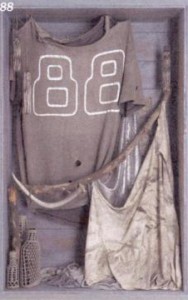
Previously known for sculptures of sequined deer and other strange fauna, Marc Swanson seems to be hunting different trophies in his current show. Although a pile of sparkly black antlers greets visitors, a nearby wall-mounted case – a sort of reliquary containing a grungy football jersey and a swath of glam fabric – indicates that the artist is shifting his aim from animals to humans.
Also new is the incorporation of geometric patterns or diagrams – related, apparently, to personality testing and psychiatric evaluation – into several of the pieces, most chillingly Love is All Around (2007), a video created with Neil Gust. In it, we see a shirtless young man with DEVOTION tattooed across his chest posing against a tinseled backdrop in a red-lit room. A network of lines running over and behind him suggests that not only is his body being subjected to some creepy kind of analysis, but his mind is too. In the back gallery, viewers find themselves similarly dissected, thanks to two sculptural installations incorporating mirrors behind radiating webs of string and wood.
Even more disconcerting is another vitrine in which grimy t-shirts are covered in latex to form a giant hide pierced with thin gold chains. The piece recalls an earlier Swanson effort created out of T-shirts, a sort of boat sail evoking sweaty erotic camaraderie. But here, the resemblance to flayed skin, and the dark undercurrent of the other works in the dimly lit gallery sends a far more sinister message.
Andre Butzer at Metro Pictures
For ‘Time Out New York’ Magazine
On a recent weekday, the traffic at Andre Butzer’s first New York solo show flowed in and quickly back out as skeptical visitors encountered the young German painter’s garish, Expressionist renderings of cartoony characters. Butzer’s brightly colored, monumental canvases are an amusing finger in the eye of prevailing taste – the ‘lessness’ exemplified in the Whitney Biennial – but their role as harbinger of a sea-change in art world fashion is greater than their value as art.
In the first gallery, four huge portraits of Euro-American pop-culture hybrids sport Mickey Mouse gloves and faces resembling cartoons, SS death heads and Munch’s screamer, though none are particularly amusing or menacing. Phallic projections in place of arms recall Caroll Dunham’s grotesque, penis-nosed characters but without the mystery, while the figures suggest the kitschy colors of Kenny Scharf but not his surreal creativity.
Among his own generation of painters, Butzer evinces stylistic similarities to Jonathan Meese’s colorful impasto canvases and Bjarne Melgaard’s messily rendered quasi-humans. But while their free manner with paint is accompanied by developed, albeit personal storylines; Butzer’s deadpan, recurring characters dangle the potential for narrative in front of their audience without really delivering.
The worst culprit is ‘Viele Tote in Heimatland: Fanta, Sprite, H-Milch, Mickey and Donald!’ a nearly thirty foot long canvas arranged with spectral heads surrounded by thin layers of splashed and slapped on paint. Despite the title’s suggestion of a German-American cultural mash-up, Butzer’s ambition to cover that much yardage trumps his ability to come up with appropriately tour de force subject matter, making for a disappointingly flashy debut without much substance.
Tamy Ben-Tor at Zach Feuer Gallery
For ‘Time Out New York’ Magazine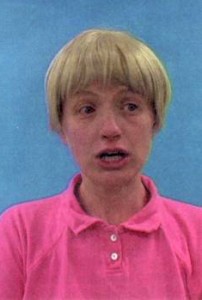
People are idiots. That is the takeaway from Tamy Ben-Tor’s second New York solo show, which offers four new videos that fearlessly skewer the racism and misunderstanding between not only Jews and gentiles, but among humans as a whole. Using characters too foolish to be believed (including obnoxious art-world denizens), Ben-Tor shifts targets between the ugliness directed at entire groups, and the relatively harmless shortcomings of her peers.
Despite the title of the main piece, Gewald (translatable as ‘violence’), Ben-Tor skirts direct confrontation, or provocation for its own sake. Her characters are laughable enough to be dismissed along with our own culpability in prejudice. Yet stunningly acute insights slipped into fleeting scenes or absurd utterances – a Hasidic woman denying that anyone would ever want to hurt Jews; a ditzy Fraulein still ‘duped’ by Hitler – allow Ben-Tor to lay bare our capacity for ignorance without getting on a soapbox.
If these characters created by Ben-Tor (who just recently performed her live work Judensau, at the Kitchen) are fantastical, her portraits of a frustrated curator, an artist laughing all the way to the bank and an arrogant art critic are also strangely off kilter. Contrary to the supposed careerism of today, a frazzled curator can’t get artists to return her e-mails, while an aggravated critic who “doesn’t even like art, let alone love it” is hilarious but probably not too representative of her ilk. Will Ben-Tor’s jumbled characters actually prompt self-examination? That will be the test of how deep our idiocy runs.
Katy Moran at Andrea Rosen Gallery
For ‘Time Out New York’ Magazine, April 2008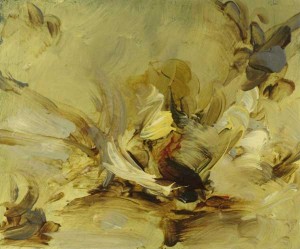
After tantalizing appearances in group shows, Katy Moran’s first New York solo affirms the young British painter’s talent for evocative abstraction. The paintings are rife with apparent contradictions: they’re small in scale yet best viewed from a distance, misty veils of white shroud the subject matter, and titles may mislead more than enlighten. Moran’s approach occasionally feels like a self-conscious gambit, but it keeps viewers guessing long enough to come to provocative conclusions.
Most canvases display the artist’s brushy, layered style and earthy, cool color palette, yet the mood of each comes as a fresh surprise. ‘Lucas’ (2007) is an ethereal cascade of blue and white that could be a waterfall, hazy beach or snowstorm. Alarming splashes of blood red dot a dark oval form that might be a boat or an open grave in ‘Volestere’ (2007). Light paint daubed over dark in the show’s most dramatic piece suggest a battlefield at night, though the title, ‘Wasabi Without Tears’ (2007) turns the painting into a funny take on high-brow, culinary machismo.
Other canvases distill the essence of different moments in the art historical canon: A cow’s head emerges from a patchwork of Futurist volumes; elsewhere a DeKooning-esque crone is rendered in dark Cubist colors while in a third painting, a rough sailboat shape in a light-toned setting recalls a Dutch harborscape. Occasionally, Moran’s jumble of forms fails to materialize into anything meaningful and her grungy color schemes can be garish. This is rare. Instead, the new work convincingly stakes Moran’s painterly territory: historically astute with a dash of humor, making nods to Karen Kilimnik’s romanticism and Cecily Brown’s jittery fluidity while possessing an energy all its own.
Los Carpinteros, ‘La Montana Rusa,’ at Sean Kelly Gallery
For ‘Time Out New York’ Magazine, April 2008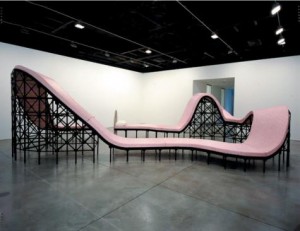
After seventeen years of exhibiting, including a memorable installation at PS1 in 2001, it’s surprising this is only the Cuban collaborative’s second New York gallery show. New Yorkers have missed out if these five new sculptures plus a suite of watercolors, which blend subtle politics, surreal domestic furniture and architectural models, are anything to go by.
Los Carpinteros’ typical sculpture is minimal, large and makes obvious references that put it at risk of seeming simplistic were it not for underlying Cuban references that add a rewarding complexity. The show’s centerpiece, ‘La Montana Rusa,’ (2008) a long, undulating bed resembling a roller coaster, brings to mind the hair-raising and uncontrollable aspects of dreams. But read its ‘socialist’ pink color as political metaphor and it becomes a timely reminder of Cuba’s present uncertain leadership.
The show’s other sculptures are portals into mysterious, dream-like worlds: A replica swimming pool with increasingly deeper chambers arranged like the layout of a house recalls the still, eerie mood of James Casebere’s photos of flooded architectural models. Three large bookshelves resemble Crate and Barrel fare but have wavy distortions that make them appear as if they were underwater or a hallucination.
Eleven watercolor drawings include buildings in the form of meat cleavers and a basketball court whose backboard arches like the trajectory of a ball. More bizarrely imaginative for not being practical enough to realize as objects, they continue Los Carpinteros’ contrast between menace and amusement, adding another edge to their provocative body of work.
Mark Handforth, at Gavin Brown’s Enterprise
For ‘Time Out New York’ Magazine
Mark Handforth’s latest solo show offers work that is both chic and out of fashion. Bold new sculptures in his usual cheeky minimalist style are a big contrast to the ephemeral and intuitive artwork being championed in the major survey shows at the New Museum and Whitney right now. Yet his best pieces combine monumentality with humor and whimsy to exert a sophisticated, mysterious charm.
Hugging the gallery building outside, an impossibly long-necked lamppost bent into a star shape extends its top around its base like a seductively crossed leg. Inside, a similarly exploded sense of scale turns a long piece of rusty pipe, bent into a heart and dotted with colorful burning candles, into a towering declaration of love. Whether the source is freshly mass-produced or just junk metal, Handforth’s amusingly capricious sculptures suggest evidence of a powerful unseen hand, a kind of giant Gabriel Orozco cum Boo Radley.
But when the readability of Handforth’s sculptures is too easy, as with the three pieces in the back gallery, it becomes clear why so many younger artists are rebelling against this sort of aesthetic. A star with two broken tips dominates the room, and also appears on an announcement card for the show in which it is ironically depicted as standing in for Mammon, Lucifer’s demonic follower in Paradise Lost. The piece’s lasting impression, however, like that of two snake-like coils of ropes and a light installation depicting a tumbleweed, is signature Handforth: made to please the eye and titillate with a knowing yet shallow allusions.
Manfred Pernice, “diary” at Anton Kern Gallery
For ‘Time Out New York’ Magazine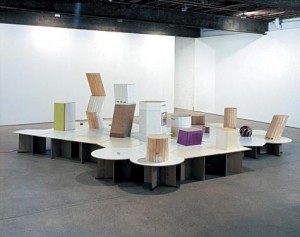
Given the impenetrable nature of Manfred Pernice’s work, you wouldn’t confuse him for an introspective soul. Despite its title, his latest show does little to change his trademark reluctance to communicate clear meaning. Instead, a mysterious centerpiece sculpture—emblazoned with unexplained dates, dotted with everyday objects and accompanied by giveaway pamphlets stamped DIARY#8212;tentatively suggests that experience is subject to many interpretations.
A few zones of fluorescent green and deep red on the central installation are among Pernice’s few concessions to aesthetic appeal. But for those willing to grasp for associations, a honeycombed-patterned platform suggests an after-hours cafeteria, while empty plinths evoke museum or trade-show displays. If those same pedestals could also be imagined as buildings in a model urban landscape, then a kid’s ball could be a stadium, while a tiny floral tile might be seen as a garden. Who’s to say?
Certainly not Pernice, whose “diaries” mix dates, texts and underwhelming photos of blurred or mundane scenes. One unremarkable photo of a man carrying a bag is captioned EXPRESS YOURSELF, while another image shows the artist with a glazed look in his eyes. Both touch on the challenges of being original, but beg the question of why Pernice can’t provide his audience a few more clues to understanding his work.
As if anticipating such criticism, a sculpture in the back gallery consists of nothing but empty boxes (for cookies, cigarettes, etc.), dated to create a chronicle of the artist’s activities. While appearing to go in a direction diametrically opposed to the rest of the show, it still maintains the same line that artistic identity is ultimately elusive.
Betty Woodman at Max Protetch Gallery
Max Protetch Gallery Feb-Mar 2008.
Betty Woodman's sculptures/ceramics/paintings bring beauty back to the art world.
Mai-Thu Perret, “An Evening of the Book and Other Stories”
For ‘Time Out New York’ Magazine
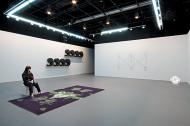
Mai-Thu Perret’s first solo exhibition in New York aims to mine past avant-garde movements for newly provocative images and ideas, but provides little of either. What you do get are lots of arcane references underscoring the video, sculpture and diagrams. Take for instance, the show’s centerpiece video of young female dancers in utilitarian garb which, according to Perret, is inspired by artist Varvara Stephanova’s set designs for Vitalii Zhemchuzhnyi’s 1924 agitprop theater piece ‘An Evening of the Book.’ You wonder whether knowing any of this is worth the piece’s slim rewards.
The front gallery offers an oddball assortment of artworks, including a ball of neon tubing looks like a wadded up (rejected?) version of props the Geneva-based Perret has previously shown, a carpet with a Rorschach pattern and large wall diagrams of dance steps. But nothing quite sums up the pointlessness of this show better than the eight gigantic, cardboard commas – which tellingly resemble quotation marks – that line a wall leading to Perret’s take on Zhemchuzhnyi’s homage to revolutionary literature.
The same commas, along with a huge blank-paged book, appear in the video as part of a set, around which the aforementioned cadre of young women performs synchronized movements that see-saw between energy and lethargy. Apparently unable to sustain the stamina to convert past ideology to present-day meaning, the characters convey the disappointing message that such attempts are better in theory than practice.
Dan Perjovschi, “You Remember My Pin?”, at Lombard-Freid Projects
For ‘Time Out New York’ Magazine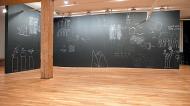
Even if Dan Perjovschi’s doodle-like, politically charged wall drawings seemed a little out of place in MoMA’s pristine atrium last year, the incongruity created a certain frisson. His first New York solo show is just as arresting, despite being relegated to a much smaller space. Using white chalk on gray walls, the artist turns the gallery into a giant blackboard on which he has scrawled lively if uneven critiques on issues ranging from the environment to Iraq.
Perjovschi’s nervous line, and his tendency to overlap bold and faint images by erasing as he goes along, give his work an energetic, experimental feel. On the downside, drawings of a naked derriere surrounded by puckered lips and of a puppeteer making anonymous figures dance, amount to little more than generic symbols. Perjovschi’s spontaneous approach often misfires, as in his unnuanced drawing of a giant trash can scrawled with .
Most of the time, however, Perjovschi’s economy of means yields more trenchant results. A sun labeled rich on one side and poor on the other emanates more rays on the “poor” side—a concise commentary on the inequity of global warming’s impact. The clarity, punch and provocation of such pieces suggests that they’d be just as at home outside as in a gallery—which would be just as well, given Chelsea’s recent profusion of mindless street art.
Diana Thater, “Here Is a Text About the World”, David Zwirner Gallery
For ‘Time Out New York’ Magazine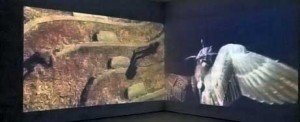
Diana Thater has spent the last year learning all she can about chess and falconry, but don’t expect her latest video installations to provide much edification on either topic. Thater doesn’t seem interested in educating her audience about these ancient pastimes, leaving the viewer frustrated as well as tantalized.
Unlike the participants in a dog show, raptors don’t take too kindly to competition, so the set-up of the exhibition’s most engaging video, Horus, is immediately puzzling. As Thater’s camera swoops overhead on a crane, falconers of different ages and sexes sit with their birds in an atmospheric ampitheatre as if waiting to go on. Nobody goes anywhere, however, which only makes you wonder what all the medieval-looking hoods, straps and other equipment used to calm the birds say about the piece’s apparent subject – the relationship between falcon and handler.
Likewise, Thater promises stories without really telling any in a series of individually titled video reenactments of legendary chess matches. In Gary Kasparov vs Deep Junior, for example, we see the legendary Russian grand master pitted against a computer, a contest which certainly offers fertile symbolic possibilities. But absent the gallery’s explanatory handout, it looks just like the other videos in this group, all of which show similar scenes of hands moving pieces on a board. Even so, Thater’s work, beautiful as it is, inspires at least an appreciation for her subjects (her players move their fingers with the poise of dancers). It may entice you to find out more.
Tobias Buche at Lehmann Maupin Gallery
Jan-Feb 2008.
Sculpture that tries very hard not to look too good. Tobias Buche's deliberately low-grade sculpture conjures a curious portrait of his inner world. Take Merrily Kerr's video tour of this work at Lehmann Maupin Gallery in Chelsea.
Kara Walker at Sikkema Jenkins
For ‘Art on Paper’ Magazine


By the time Kara Walker’s first full scale American museum survey arrived at the Whitney Museum from the Walker Art Center last fall, a wave of press coverage, including feature articles in the New Yorker and Art in America, made it the must-see show of the season. But it was the fifty-two-panel, handwritten text in Walker’s simultaneous downtown gallery show that deserved the attention. Flanked by smaller works in her signature cut-paper style illustrating atrocities committed against freedmen after the Civil War, the enormous text installation, with an equally expansive title (Search for ideas supporting the Black man as a work of modern art/contemporary painting; a death without end, an an appreciation of the creative spirit of lynch mobs), stood out for its sheer unornamented rawness—no illustrations, just scribbled handwriting—and its scathing references to U.S. military action in the Middle East.
Since the mid-nineties, Walker’s silhouettes, paintings, videos, and projections have consistently conjured imagery of the Old South in abject yet clearly readable scenes of violence and sexual subjugation. When she used text, it was written in what could plausibly be the artist’s own perspective or that of an alter ego. Her more recent text-based work (since 2002) adopts a range of voices—anthropologist, slave, contemporary middle class African-American.
Search for Ideas is an even more cacophonous brew of observations and perspectives. Here, Walker explores the potential analogy between racist attitudes in America and those perpetuated by Americans overseas in texts that refer to Saddam Hussein as a “porch monkey” or Arabs as “sand niggers.” Under the rubric of aggressor and complicit victim, the text details rapes and torture, proffers that black soldiers are willing Klansmen and asks, in the face of global jihad, “how can colored folks get on the winning side w/o giving up their hard-won right to jeans that fit…” Because the fifty-four parts are hung cheek-to-jowl and there is no obvious sequencing, it is unclear whether one is supposed to read them left-to-right, or top-to-bottom.
Likewise, the show’s small cut-paper works and large-scale collages on panels lack clear storylines, such as ReConstruction (2007), a decorative mélange of floating silhouetted heads over a background of post-9/11 New York Times ads offering condolences.
From Richard Serra’s 2005 poster recreating a scene from Abu Ghraib to Jenny Holzer’s presentation of declassified documents pertaining to military bungles in Iraq, among many other examples, Walker is not alone in using her artistic platform to protest U.S. foreign policy. Yet Search for Ideas seems uniquely geared to offend and disturb by its graphic descriptions of violation, its willingness to lay blame all around, and its success at tapping another well of middle-class guilt, this time over atrocities committed in the name of the American public. A schizophrenic toggle between individuals and nations, and between first and third person, makes for a confusing and overwhelmingly despairing indictment. However, as a grating tour de force of ugly truth, the piece is powerfully effective and makes a loud riposte to one text’s assertion that “Knowledge comes in the form of whispers of those in the know.”
News and Commentary: The More Things Change
For ‘Art on Paper’ Magazine

Visitors were in for a surprise at Mary Boone Gallery recently, when the normally frosty atmosphere was melted by the folksy artwork of artist Aleksandra Mir and her team of assistants. Music blared from a boom box, while collectors rubbed shoulders with young hipsters in what looked like an art studio. In a back office, cordoned off but publicly visible, Mir hand-copied onto huge sheets of paper the front pages from hometown tabloids the Post and the Daily News, dating from 1986 to 2000. When she was done, her drawings were transferred to the main gallery where a Sharpie-wielding team of young artists and students diligently filled in her outlines. All in all, some two-hundred drawings from approximately ten thousand front pages were generated.
Mir claimed that she couldn’t care less about the gallery’s newly congenial or keyed down ambience, saying, “That’s the subject that interests me the least. I’m not interested in institutional critique but in having been a citizen of this town.” Yes, it’s true that the project broadcast a fond nostalgia for the city that the Polish born, Sweden-raised artist recently left after a fifteen-year stay. In some the headlines emphasized the entertainment value of the New York tabloids: a ‘Burger Murder’ poisoning was treated with as much import as a ‘Milk War’ waged on grocery prices. In another group, the headlines were linked by money— ‘Killed for a Quarter’ and a $1.5 billion coke bust—highlighting one of the city’s fondest obsessions. Here was a city perpetually enchanted by the same recurring stories; the drawings seemed geared to prove the cliché, “the more things change, the more they stay the same.”
Yet, the high-polish context begged otherwise, revealing instead just how much the art world had changed. The exodus of galleries from SoHo to Chelsea began during the period Mir examined and, in the opinion of many, precipitated a new fashion in art for work made on a scale and volume calculated to fill newly pristine and vast galleries, as well as an unprecedented alignment of real estate and art. By working in the gallery, Mir aimed to emphasize the fact that she never maintained a studio in New York, working instead without the need for one. But the effect was somewhat different, unintentionally acknowledging a situation whereby artists can no longer afford the city’s rents. Mir became the emblematic displaced artist of today, shunned not to the sidelines as in times past, but to center stage, a peripatetic entertainer in a theater of gold.
Mika Rottenberg, Long Hair Lover
For ‘Flash Art’ Magazine

The female body, in all its potential fantastic proportions, obsesses Mika Rottenberg. Her eccentric videos have featured body builders, dancers, wrestlers, and porn models laboring in confined, assembly-line settings to manufacture unusual objects related to the body: fast-growing fingernails morph into cherries, perspiration becomes the scent for tissues, and in the video ‘Dough’ (the highlight of her first New York solo gallery show early in 2006 at Nicole Klagsbrun Gallery), the tears of an obese beauty cause dough to rise.
More recently, Rottenberg has abandoned her cramped studio in favor of the wide-open spaces of the natural world. Inspired by the story of the Sutherland Sisters, a 19th century family of girls who displayed their extra long hair in a Barnum & Bailey performance and marketed their own hair growth formula (supposedly including mist collected at Niagara Falls), she worked with members of a present day long hair club to make the short trailer, ‘Chasing Waterfalls: The Rise and Fall of the Amazing Seven Sutherland Sisters (part one).’ As winner of the inaugural Cartier Award, Rottenberg screened the video at the 2006 Frieze Art Fair, giving her audience a tantalizing glimpse of the related project on which she is now working.
MK – Your videos have been set in an enclosed space; now you’re working outdoors. What has that shift been like?
MR – In past pieces like ‘Dough,’ I built one part of the set at a time and worked individually with each actor. I wanted to see what I could do with limited space. Now, I’m interested in finding out what I can do with no spatial limits, so I’m building a set completely from scratch in the middle of the woods.
MK – How did you choose the location for your shoot?
MR – The actors in the trailer are part of a long hair lovers Internet club, and three of them live near one town in Central Florida. I actually wish I could write a sitcom about the RV park/ retirement community where I’m staying. People there have a lot of time on their hands, which makes them creative – they do things like have their own parades. The Boy Scouts are even going to help me behind the scenes. Thanks to a piece in Vanity Fair, I got permission from a local farmer to do whatever I want with a huge piece of land that includes a petting zoo that no one visits.
MK – Has your normal working process had to change?
MR – My process usually follows several distinct stages: I start with drawings, which come purely from my imagination; then I try to find people I want to work with; I build the set or sculptural environment; then work with the actors in the space, making a lot of set changes. Eventually, there are always moments over which I have less control, as when I introduced the dough in ‘Dough.’ There’s gravity and you know it’s going to go down, but I don’t know how a person is going to behave. I try to keep the camera on all the time so I have hours and hours of footage, but often, the material I actually use is from moments when the actors forget the camera is on. My first thought for my current project was to mimic a reality TV show by creating a space – in this case, a functioning 19th century farm – and asking the women to just be there for a week. The scenario, along with their bad acting could really make it ridiculous and funny.
MK – Will there be similarities to your previous themes?
MR – The project is in the beginning stages and could still go in so many directions. But like my other videos, I want the whole story to revolve around cause and effect – presenting a problem and then solving it. It may be a poor farm and the women bad farmers. Something will break and that will trigger the next thing, a method that will promote the story and develop the characters. I’m thinking in an almost sculptural way and trying to have the story be more physical, because I can’t write dialogue!
I’m inspired to think of the farm as a giant Earthwork in the sense that it’s a zone for experimentation with earth. There are parallels between the incredible amount of labor that goes into farming and the routines the women adopt to care for their hair, such as brushing it daily for two hours. I spent this week trying to make a device that would convert the strokes of a hairbrush into an energy source that could power other things on the farm, though I’m not sure I’ll even use the device in the final version.
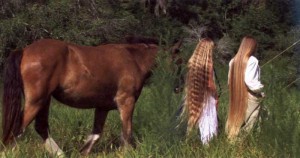
MK – You closely associate the women with nature, whether it’s being near a waterfall or on a farm.
MR – My videos employ clichés about femininity, and this one involves associations between women, fertility and the earth. I’m attracted to how these trite ways of thinking about women offer a kind of bliss, that is, they satisfy a basic desire for resolution and simplicity. I’m a sucker for the related visual images – girls playing with little lambs and bunnies, waterfalls, and long blond hair blowing in the wind. But the fun really starts when I dissect the clichés, turning them inside out and showing them as they really are – creepy and uncanny.
The Sutherland Sisters started selling their hair fertilizer as a result of the Industrial Revolution. They marketed their product right after chemical fertilizers for the soil came on the market, implying that if you could grow grass that much faster, then you could also grow hair. I like the contrast between male baldness and a super abundance of female hair.
MK – Certain aspects of the trailer remind me of a romance novel or soap opera.
MR – Absolutely, because its about entrepreneurs and new horizons. It blurs the line between cheesy, funny and genuine.
MK – Have you intentionally used humor in your past work?
MR – Whenever I try for it to be funny, it’s probably not, so I don’t. In ‘Dough’ there’s more of an awkward weirdness and element of grotesque that might come across as funny. It actually depended on the reaction of the other people watching the screening; if people were laughing you felt like it was funny whereas if people were serious you felt unease.
MK – That video seems to intentionally subvert conventional notions of beauty. The obese woman is pretty whereas the thin woman’s proportions are grotesque.
MR –I don’t know if I consciously think in terms of beauty or subverting beauty. My interest is more in things that the body produces and the way you use the body and it becomes more like an object. Some long-haired women relate to their hair like it’s a pet. The Sutherland sisters were smart not to cut and sell their hair, but to keep it and use it as an object in their Barnum and Bailey act.
MK – Is your art about society’s response to their extremes?
MR – I don’t think it’s about society’s reaction to long hair or fat people. It’s about society’s interaction with the body in all its possibilities. Of course, there’s a layer that relates to American obesity, but that’s not my focus. Instead, it’s more about taking something to an extreme to examine it. If the dough is a stand-in for the body, there’s a fantasy about the body’s ability to stretch as if there’s nothing inside.
And it’s also more about my personal attraction to long hair or to big bodies, for example. For my video ‘Time and Half’ I’d been looking on the Internet for someone with really long hair and then saw a woman on the subway. In that piece, I manipulated the background (a Chinese takeout restaurant) by adding more palm trees to emphasize how the girl and her hair are so exotic.
MK – Could you be accused of exploiting your characters?
?MR – I’m always waiting for that question. In a way, I am using the actors almost as objects, which is supposed to be a bad thing to do. I’m not trying to be a saint, and I don’t think the artist’s part is to be “the good guy.” I often feel uncomfortable in the position in which I put myself, but my connection with the actors runs like an experiment, a behavioral observation or a motion study. I can see how that can be exploitative, but it’s hard to make work about that without actually doing it. You could argue that we have an equal and satisfying relationship serving each other’s needs as exhibitionist and voyeur.
MK – Does your work come from a feminist perspective?
MR –I’ve always defined myself as a feminist. There is an aspect of misogyny in my work that is a response to the way society in general is. So I have to ask myself what it means to be a “good” feminist. If I use peoples’ bodies and objectify them, then I’m a bad feminist, or I’m promoting the usual stereotypes. But since these are so common in daily life, it’s a way to negotiate or understand them and make them empowering. I keep questioning my own morality.
MK – There’s another –ism that relates to your work. Can you tell me about your references to Marxism?
MR – The very definition of labor is the process between a person and nature, but actually, I’m interested in Marx’s writing in an abstract way, as more poetic than political. The way he describes production and a person in motion is both beautiful and very visual. What’s inspiring to me is his way of measuring units of energy, materials and time involved in labor. Everyone assumes that in ‘Dough’ there is an end product, but in my mind, the rising dough is constantly growing in volume so the excess that is pushed out is really more of a unit that measures work. The process of handling the dough also uses the forces of nature like gravity, allergies and other reactions. In the new video, I’m growing crops and thinking of how to control the animals’ movement by harnessing their desire for food. It’s almost as if they’re the dough.
MK – What do the women in the long hair club think of reconnecting with nature?
MR – They’re each different but are all high maintenance. You have to be when you have hair that long. It gets delicate and they count every hair and split end. Most of the time it’s up, but when they take it down, it’s like a ceremony and their mobility can be almost paralyzed. But each has a unique relationship to her hair, and unlike my past videos only one of them makes a living (running a soft-porn website) from her unique feature. Very long hair is attractive to a lot of guys, but the women distinguish between the fetishists and the long-hair lovers. If they meet a man, he has to pass tests to make sure the attraction isn’t sexual, although, of course, it’s sexy.
MK – This sounds like a whole new way in which truth is stranger than fiction.
MR – Like my other videos, I’m setting up a situation and trusting reality to do the job. People might say that my work is absurd, but reality is even more so.
Wayne Gonzales at Paul Cooper Gallery
Paula Cooper Gallery May-June 2007. Wayne Gonzales' paintings of crowds zero in on the American public, emphasising its divisions. Take Merrily Kerr's video tour of this work
Allen Ruppersberg, Poster Child for a New Generation
For ‘Art on Paper’ Magazine
- Allen Ruppersberg, The Singing Posters, 2003. Installation at Rice University Art Gallery, c. 2004 Hester and Hardaway. Photo by Paul Hester (detail)
At sixty-three, Allen Ruppersberg, the thoughtful maverick whose work has returned again and again to posters and books, is finally getting his due.
Today collectors are hunting for underappreciated talent – value-investing, you might say – while young artists with an apathy or a disdain for the machinations of the gallery system are looking for less market-friendly role models. Both may, in part, explain the increasing interest in Allen Ruppersberg, the Los Angeles and New York-based artist whose work was recently the subject of a survey in Europe and was brandished on the March cover of Artforum magazine. Ruppersberg’s cross-disciplinary approach, his embrace of pulp fiction, film, and quotidian graphics, and clever recycling of his old art for new have defined an innovate career that is still unfolding. Of particular interest, especially to artists, is his ongoing use of both posters and books, formats that remain excluded from the art historical canon.
From the early days of his career, Ruppersberg pushed the boundaries of what art could be. In 1969, two years after graduating from the Chouinard Institute in Los Angeles, he established a short-lived cafe in which he served plate-size helpings of environmental art, followed by a similarly short-lived hotel/art installation. By the early 1970s, his love of literature began to manifest itself in artworks based on books, which, since then, have taken many forms, among them text-paintings, installations, and public art projects. In the early 1980s, he hit on the idea of making artwork that mimicked the highly commercial, colorful advertising placards ubiquitous in L.A. at the time.
Ruppersberg has a vast collection of postcards, books, movie posters, films, magazines, ephemera and other pop culture artifacts that he uses as a resource for his work. Speaking about the time the artist spent in New York (from the mid-80s through the 90s), Christine Burgin, a New York dealer who has worked with him since the late 1980s, recalls, “Al came to New York and collected CBGB and Mud Club posters, archiving them as if they were fine art.” Burgin adds that in his artwork, “he uses posters of his own making – along with leftovers from jobs printed by other clients of the company that prints them – to disavow authorship, presenting them as they exist in the world.” ‘The New Five Foot Shelf’ (2001), a major installation by the artist, includes a fifty-volume publication with texts written or collected by the artist, and forty-four poster scale ink jet prints that document—photographically—the interior of his old library-like Manhattan studio.
‘The Novel That Writes Itself,’ an epic work that is ongoing, has to be the crowning poster project of his career. Although originally intended to be realized in another form—Ruppersberg sold roles in an autobiographical novel back in 1978 but the project languished before being reborn in poster form – it now consists, in Ruppersberg’s estimation, of more than 800 posters. These include the pages with ads, duplicates, and his own text. More posters are produced each time the piece is installed. Displayed floor to ceiling, the posters have an eye-catching quality while perversely championing a form of communication considered lower than pulp.
In a multi-part work from 2003 and 2005, titled ‘The Singing Posters’, Ruppersberg used this formal precedent to pay homage to a now historical text once deemed obscene: Beat poet Allen Ginsberg’s ‘Howl.’ The piece consists of a phonetic rewriting of the poem, using changing typefaces, that is printed on nearly two hundred multicolor posters. Whereas most posters are designed to be read at a glance, but these force the viewer to puzzle out the poem, word by word, poster by poster.
Ruppersberg may be reflecting on his own influences in projects like ‘The Singing Posters,’ but others are looking to his example as they find their own artistic voice. Artists like Mark Bradford, Evan Holloway, Scott King, and Carl Pope have all used posters in this work, while other young artists have closer conceptual parallels to Ruppersberg, including Carol Bove’s sculptural installations of books from the 70s, Bernadette Corporation’s cribbing from other people’s works, or North Drive Press’ treasure troves of artist-conceived ephemera.
The new interest doesn’t signal that Ruppersberg has passed the torch, however. He has several new projects afoot, including an installation in June for the Art Unlimited section at Art Basel, for which he is preparing banners (printed by the same company that makes his posters) and thousands of photocopies based on parts of his collection which visitors can take away. There, at the momentary center of the international art world, he will be perfectly positioned to influence and be influenced, to participate in the market and distance himself. “It’s the same dialogue and process of artists talking about common ideas,” he observes, “…but a new generation looks at things differently, and that’s inspiring.”
Gordon Matta-Clark & Rirkrit Tiravanija at David Zwirner
This month, the exhibition mostly likely to get people talking earns its 'hottest show' tag by literally applying the heat to gallery visitors. As part of an installation, daily vats of feisty Thai curry are prepared, to which visitors can help themselves. Dealers, critics and art world luminaries have been spotted indulging in a spicy lunch at tables and chairs scattered around a plywood structure which replicates 303 Gallery's space in Soho, where the piece was first exhibited in 1992. Tiravanija reveals his indebtedness to Gordon Matta-Clark's precedent-setting café, 'Food' and his unconventional use of real estate by sharing the gallery space with a recreation of Matta-Clark's 'Open House,' a sculpture made in a dumpster which coincidently occupied the same SoHo address as Tiravanija's exhibition when it was created in 1972.
Misaki Kawai, ‘Tiger Punch’ at Clementine Gallery
Clementine Gallery January 2007.
Kawai’s slapdash painted collages take a jab at slick, manga inspired art.
A Flood of Details: Digging Into Yun-Fei Ji’s Source Material
- Yun-Fei Ji at his drafting table, courtesy Yun-Fei Ji and James Cohan Gallery
Yun-Fei Ji’s monumental new landscape paintings, depicting scenes along the winding banks of the Yangtze River just prior to the area’s flooding by the Three Gorges Dam, are composed of imagery sampled from a vast archive of photographs, notes and sketches he has developed on several trips to China over the past five years. In the paintings, day laborers, moving trucks and departing residents occupy the cities and villages amid tranquil, mountainous scenery. The inclusion of fantastical characters and otherworldly scenarios distances the delicate ink on paper paintings from pure documentary. Still, the volume of primary research behind each image is in and of itself highly significant.

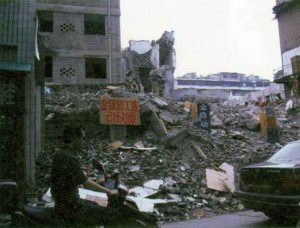
Before Ji made his first research trip to the Three Gorges region in 2001, he investigated the area’s rich history and turbulent politics, delving into its literature, following news reports, and reading blogs detailing often tragic stories about locals affected by the dam project. During his travels, he amassed tens of thousands of images and reams of notes, which he organizes by geographic location upon returning to his studio, storing the digital photographs on CDs and filing away clippings and other ephemera. Although he has no routine habit of accessing his archive (and sheepishly admits to sometimes losing track of what he’s collected), for the latest series, Ji dug back through his images in search of the period before the flood. “In each picture, I can point out a detail that interested me,” he says. The photographs in Ji’s archive depict a wide range of subjects, among them tidily stacked building materials, doors and windows waiting to be taken and reused, scavenging day laborers and the ubiquitous camps of holdout residents who refuse to move until the last minute.
Ji draws from computer printouts or while looking at photos on his monitor, improvising as much as he copies. “I’m not just adding things up when I work,” he says. “I find details that trigger my interest and imagination and act as a stepping point to something else.” Ji’s sketches can also originate just as easily from an idea generated during a conversation, from a found photograph, or, from other found source materials. In one case, a propagandist magazine cover from the 1950s showing happy farmers in a time of widespread famine inspired an etching of cadaverous landsmen, while in another, accumulated tales from the demolition workers resulted in a painting of a scavenger’s wife communing with the dead.
“There is almost nothing that I don’t draw,” says Ji, referring both to the large number of drawings that cover the walls of his studio and fill his sketchbooks and to their varied subject matter, from studies of plant life to half demolished buildings. More often than not, he’ll sketch a subject multiple times; occasionally, Ji collages together disparate sketches, then paints from those. In keeping with his unique style – informed by studies in both Eastern and Western art – Ji explains his process as “…translating everything into line and brushstroke. Though my work uses photography as source material like many Western painters, its very different because I’m not using light and dark shadow.”
Ji’s paintings, like his drawings, result from tireless preparation and intuition. “Sometimes, I’ll start with a vague idea, not knowing where I’m going, and slowly it will emerge what the painting is about,” he explains. This approach requires a concentration that the artist likens to walking a tightrope. Each careful step of the painting involves using calligraphy brushes to build up an area with layer after layer of paint, which is applied using brush strokes like the staccato ‘ax’ or curly ‘buffalo hair.’ Working on a table covered with felt for absorbency, Ji applies paint and sometimes washes it to reduce its intensity, giving the mulberry-paper background of his most labored-over pieces a weathered appearance.
That Ji’s recent paintings derive from images and notes he recorded as he witnessed the mass relocation effort is poignant, but also helpful in explaining the surreal, disjointed quality that these works sometimes possess. Buildings, people and plant life can appear to float on the painted page like objects bobbing on the water after a shipwreck, and a rock formation is as carefully rendered as a cluster of displaced villagers. The technique evokes the dreamlike way in which memory can function, or history is written, bringing certain details into clearer focus than others and telling stories that might otherwise remain submerged.
Ivan Navarro: ‘Concentration Camp’ at Roebling Hall
‘Concentration Camp’ at Roebling Hall December 2006
See how politics and neon converge.
Evan Holloway, at Harris Lieberman
For ‘Time Out’ Magazine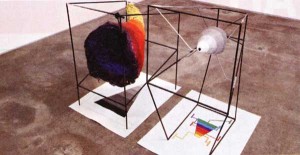
As the title of L.A. sculptor Evan Holloway’s New York solo debut, “$ocial epi$temology,” suggests, the artist is known for two things: formal whimsy and theoretical sources. This show of seven sculptures makes good on the former, but hits a snag when works fail to do more than turn postulates into punchlines.
Several sculptures refer to scientific or social principles, but eschew complexity for humorous effect. Second Law,” a spindly metal wheel poised over a plaster box studded with batteries, illustrates a Newtonian law of motion: An object will change velocity if pushed. Visitors are invited to spin the wheel as if they were playing a game on the midway. The show takes its satirically heady title from a tower of multicolored, clownlike heads with Rudolph-style bulbs in place of noses – a carnivalesque spectacle that sheds little light, blinking or otherwise, on the social significance of knowledge.
The number of one-liners here makes you wonder if these are the strongest examples of the artist’s work (some viewers may fondly recall the subtler objects included in the 2002 Whitney Biennial). One happy exception is the diagrammatic “Asymmetry Demonstration,” which pairs a large, colorful cornucopia with a smaller black-and-white cone, each suspended in its own metal frame and resting on a chartlike drawing. A better illustration of the artist’s caprice than any intricate system, it reminds us that beauty and a way with materials are the bedrock of art.
Jesse Bercowetz & Matt Bua, at Derek Eller Gallery
For ‘Time Out New York’ Magazine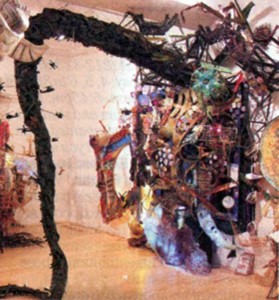
Jesse Bercowetz and Projects (a collaborative with Carrie Dashow) felt compromised by restraint. Judging by the riot of knockabout sculptures assembled from junk crowding “Things Got Legs” at Derek Eller Gallery, the pair seems determined not to make the same mistake twice. From the spinning head located inside the front door to the flashing lights of a dungeon-like installation in the back room, a carnival atmosphere prevails. But at times, a lack of focus threatens the potential punch.
The show’s energy and disorder stem from the same source: the artists’ enthusiasm for conspiracy theories and folktales, with many pieces confusingly alluding to several at once. The book-laden sculpture “Library” includes an extensive cache of audiotaped interviews with writers on topics like non-Al Qaeda 9/11 plots, secret government experiments and ESP. Across the room, “Can Jet Fuel Melt Steel?,” a rickety model of the WTC towers, constructed from shish kebob skewers and topped with a bowling ball, seems to mock a theory that many of those authors take very seriously.
Bercowetz and Bua’s uncritical approach sometimes backfires. In the rear gallery, an altar festooned with black fabric and lanterns suggests Halloween-party décor more than its purported subjects, child abuse and murder. But questioning the line between truth and fiction – as most of these works do – relates more than a little to the endless spin of our own political climate, giving this show a relevance that insouciance doesn’t diminish.
Dario Robleto, at D’Amelio Terras Gallery
for ‘Time Out’ magazine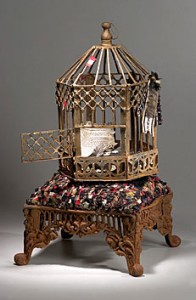
He has had more than a dozen solo shows (including one at the Whitney Altria); now Dario Robleto makes his New York gallery debut with a deceptively modest exhibition titled “Fear and Tenderness in Men.” Small, intricate, folksy-looking keepsakes are displayed in frames and vitrines, lending the gallery the look of regional historical society. Fitting, since Robleto’s untitled sculptures originate from relics, which the artist transforms into moving meditations on loss.
To evoke the “male tenderness” of the show’s title, Robleto uses tokens of personal affection salvaged from American wars (Revolutionary to Gulf). His raw materials include correspondence between soldiers and loved ones, scraps of uniform fabric and shrapnel recovered from battlegrounds. In most cases, the mind-bogglingly complicated processes used to create the sculptures are their most arresting feature. A delicate birdcage is constructed from bone dust: love letters are pulped to make elaborate flowers.
At times, Robleto crowds too many layers into his pieces, Facsimiles of Civil War era bullets (used to bite down on in surgery in lieu of anesthesia) are cast in a material made by dissolving audiotape used to record poems about war and death – the checklist gives viewers a lengthy syllabus to chew on. The gesture seems excessive because the artifacts Robleto recycles – including antique wedding rings and tiny flowers made from braided human hair – embody sorrow eloquently enough on their own. Still, without making specific reference to current conflicts, Robleto’s sculptures bear witness to the grievous toll of war.
Mika Rottenberg at Nicole Klagsbrun Gallery
For ‘Time Out New York’ magazine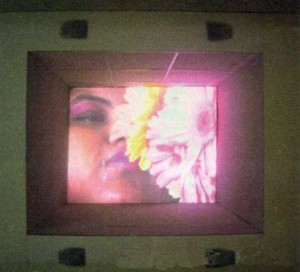
Mika Rottenberg’s unsettling videos – eccentric characters manning absurdist assembly lines – have already earned the artist fans, thanks to standout pieces in group shows over the past year. For her first solo show in New York (one large-scale video installation and a selection of drawings), the young artist ups the ante on her signature format, drawing an unnerving analogy between dough and the human body.
The video is set in a claustrophobically small, distinctly low-tech dough-packaging factory, where decorative touches – bunches of flowers, piles of towels, spray bottles – also suggest a beauty salon. As it is massaged by women in tidy uniforms, the dough clearly stands in for flesh. But far from evoking the pampered form of a spa client, the dough assumes the shape of the workers¹ bodies: An obese woman at the head of the line kneads globs of the stuff, as voluminous as her own flesh, into a skinny rope that she then passes into the elongated hands of a tall, thin woman.
Rottenberg renders grotesque both dough and flesh, baking and beautification. But fantastical moments lighten the pervasive sense of disgust. In one scenario, a woman sniffs flowers to which she is allergic, and her falling tears keep the rising mixture moist. But it is the abject subject matter of the artist’s drawings – which echo the video’s references to beauty parlor workstations, but also feature projectile vomiting, vats of yellow liquid and swarms of disembodied, snapping jaws – that laces this auspicious and entertaining solo debut with menace.
Otabenga Jones & Associates, at Clementine Gallery
For ‘Time Out New York’ magazine,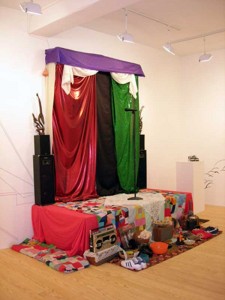
Otabenga Jones and Associates, a Houston-based collaborative that will participate in the 2006 Whitney Biennial, takes its name from an African pygmy who was put on display at the Bronx Zoo in 1906. As this detail suggests, the group is interested in the intersection of African and American history, specifically their own richly imaginative version of it as told in the show’s centerpiece: a sound installation recounting the outlandish story of Mudbone, a South Bronx MC who travels to the land of his ancestors during an out-of-body experience.
Mudbone’s tale is full of engaging magical-realist details (his crew shakes the earth as they walk to a competition; his hair takes on a life of its own and absconds). But the installation itself—a small stage decorated like an altar with a microphone; swags of red, green and black fabric; and offerings of junky items, including old sneakers and LPs—doesn’t do justice to the fabulous images conjured by the soundtrack. An amateurish wall mural, drawings and related sculptural objects feel like little more than a backup act for the main attraction.
We’re informed that Mudbone is empowered by knowledge of his ancestors, but the specifics of this revelation aren’t divulged. The tale’s ambiguity communicates an ambivalence about the possibility of constructing an African-American history. Inspiring historical figures like Harriet Tubman make cameo appearances in the tale but always in the confines of a stereotypical setting—either an urban ghetto or a forest’s dark interior. In the end, Otabenga Jones and Associates’ show hovers somewhere between an affirmation and an acknowledgment of futility.
Christopher Miner at Mitchell-Innes and Nash
For ‘Time Out New York’ magazine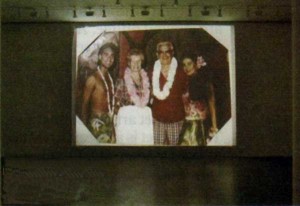
‘How Beautiful Heaven Must Be’
You may never have heard it argued that Jesus had it easy. But, in one of two videos in his second solo show, Christopher Miner points out that at least the Son of God had a purpose in life, something the artist worries he doesn’t. Such unorthodox thoughts – and the total disregard for political correctness in his second video – indicate that Miner is unafraid to grapple with the hot-button topics of faith and race in America.
In ‘The Best Decision Ever Made,’ Miner trains his camera on the memento-filled rooms in his late grandparents’ house, while comparing their stable lives and happy marriage with his own endless string of jobs, girlfriends and homes. It’s a twist on the classic prodigal-son story: Miner leaves home dissatisfied and returns disillusioned, with no one to welcome him back into the fold. By the closing shot viewers are no wiser about the title’s “best decision” as the artist listens to a gospel song by another prodigal artist, Johnny Cash.
In the back gallery, Self-Portrait finds Miner sitting in a dimly lit room, paying the role of a foul-mouthed African-American man. In a rambling phone conversation, which includes a tirade about how wrong it is for “a white man to talk like a black man,” Miner creates a disturbingly complex closed circuit of self-portrait as self-censure.
Both videos employ monologues, a classic trope of introspection, but neither is gratuitously self-obsessed. Instead, they are at once brutally honest and confoundingly evasive, leaving viewers eager for more.
Jonah Freeman: ‘The Franklin Abraham’, Andrew Kreps Gallery
For ‘Time Out’ Magazine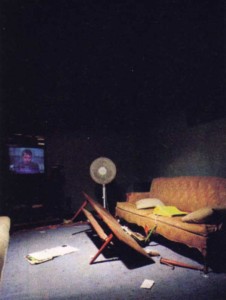
Imagine the buildings in midtown Manhattan fused together into one self-sufficient mega-structure and you’ve got the idea behind Jonah Freeman’s 55-minute-long film The Franklin Abraham (2004). It tells the story of a fictional structure-post-“zoning emancipation”-with its own industry, commerce, government and population of around 2 million.
Although such a structure is fascinating to contemplate, the glimpses of life inside the “Frankie” that Freeman provides are underdeveloped, if attention-grabbing. We’re introduced to characters like Isaac, the forelock- and yarmulke-wearing leader of the Sons of Abraham gang; but before we can learn much about him and his buddies, attention shifts to an edible prostitute (pecan flavor) and sundry, unrelated events-the building owners’ explosive family conference and the interactions of unhappy couples.
In the past, Freeman’s photographs have focused on the influence of architecture on human psychology, and The Franklin Abraham expands this investigation to an epic scale. The building Freeman depicts is consistently dreary and weirdly empty, despite its reportedly huge population. This helps explain the miserable attitudes of the residents, but we don’t need an hour of footage to understand that this utopia isn’t all it’s cracked up to be.
If more effort went into developing characters’ experiences of their unique environment and less into references to technological advances and off-screen events (such as the rioting reported in a TV news broadcast), perhaps the film might have been more satisfying. It’s a promising beginning, but if Freeman hopes to engross us in his alternative universe, we’ll need to see a sequel.
Yun-Fei Ji, The Empty City
For ‘Art on Paper’ magazine
Yun-Fei Ji is on a mission. In the past year, this Brooklyn-based painter has presented two major solo painting shows in New York that fiercely condemn the newly built Three Gorges Dam in China’s Hubei province. Last spring, Ji’s lively depictions of village life expressed equal parts affection for country life and disgust at the corruption and ignorance that threatened to make that life extinct. Now that the cities and villages along the dammed Yangzi River have been dismantled, millions of people have been relocated and the waters have risen, the mood of the new paintings is mournful. Scavengers, stragglers, and eerie skeletal figures go about their business in literal ghost towns.
Although the series is collectively titled ‘The Empty City,’ the best paintings are ironically those with the most people. ‘Bon Voyage’ (2003), the busiest, juxtaposes frantic villagers leaving their old life in the midst of swirling waters with partying tourists onboard a cruise ship on the newly widened river. In ‘East Wind’ (2003), an equally riotous scene, Red Guards make their way down a rocky, refuse strewn valley wall amongst shirtless village men who look too weak and helpless to object.
Because Ji’s sometimes bizarre animal and human characters are the most intriguing parts of his paintings, some of the less populated scenes run the risk of simply repeating his iconographic repertoire of ghostly figures moving amongst piles of building supplies and equipment. This is especially true of ‘Autumn’ (2003), in which the fall foliage is beautiful, but none of Ji’s skilled caricatures appear.
Nevertheless, by selecting the rock formations and flora of the countryside as the setting for his paintings, instead of the cities where the upheaval is more pronounced, Ji wisely chooses an intimate means to portray the destruction of a lifestyle in place for centuries. He zeros in on the frail bodies and wizened faces of a population familiar with hardship but who will now endure much worse. Haunted by the ghosts of the country’s past and unable to foresee the future in this area, Ji and others look on, helpless to stop the heartbreaking march of ‘progress.’
Hilary Harkness, Mary Boone Gallery
For ‘Time Out’ magazine
The women in Hilary Harkness’s paintings have never seemed like the sort that populate nurturing, feminist communes. But those depicted in the three new works that make up her second New York show are even less inviting. Now her slender and scantily clad stock characters inhabit exploitative class systems on a battleship and a whaling ship, and indulge their animal passions in an art-filled Alpine chalet.
Violence and fear appear to be the factors that keep workers striving toward a collective goal in each dystopian scene. In Crossing the Equator (2003), scores of wounded crowd a battleship’s lifeboats. Details-a guillotine on deck, a bugle player who’s being executed by hanging-suggest that traitors are being flushed from the ship as it is evacuated. Heavy Cruisers (2004) is also set on a ship; the double entendre of the title alludes to both the vessel and the pregnant women onboard. In a lounge area, women view fetuses in jars, while next door, others occupy double-tiered stalls to give birth.
Harkness’s paintings seem determined to challenge stereotypes of women as peace-loving; coincidentally they’re on view at a time when the prison scandal in Iraq reminds us that female soldiers are as capable of abuse as men. Harkness takes this point to an extreme in Matterhorn (2003-4), in which debauched Fräuleins torture, fight and pleasure each other in a sadistic orgy of excess. Harkness may want to imply that sexual or social transgression is the ultimate expression of individuality. Instead, with their clone-like appearance, her women suggest an undifferentiated unit. Harkness’s paintings are a chilling vision of free will yoked in service to a higher power.
Tomoaki Suzuki, at Leo Koenig, Inc.
For ‘Sculpture’ magazine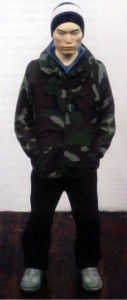
Although Suzuki is a skilled woodcarver, his subjects remain unknown to us. Like participants in a police lineup, each stares directly ahead with a blank facial expression, presenting him or herself to the viewer’s gaze. Suzuki’s portraits are three-dimensional interpretations of the impulse to document the world around us, like Thomas Ruff’s deadpan portraits of friends from the mid-80s, or Rineke Djikstra’s frontal photos of bathers, soldiers and other young people. Abstracted from the activity of their daily lives, their names, details of dress and the figures’ positioning in the gallery are the only clues we have to their identity. ‘Lucy,’ a woman with a long braid down her back wears sneakers, slacks and an unusual jacket with a pattern of handguns. Military themed apparel links an Army green camouflage jacket worn by ‘Humiyasu’ with shorts in the same material on the ironically named skater, ‘Tripp.’ ‘Kerri,’ a blond with long dreadlocks, wears a belt shaped like a round of ammunition, but her look is more Star Trek than Rambo, with her long jacket and flared trousers merging seamlessly with moon boots. Apart from Lucy’s odd jacket, the clothing is fashionable but not outrageous, youth oriented but not rebellious.
By depicting attractive 20-somethings, Suzuki traffics in the idealization of youth. His contemporary kouros and kore join an ancient tradition of sculpture depicting solitary young people, but they represent no deified ideal, just good fashion sense. Their membership in a youthful demographic and uniform adherence to a recognizable dress code set them apart from artistic projects like Karin Sander’s machine manufactured sculptural portraits of people in 1:10 scale, which depict a range of ages and show people in a variety of poses. Even Stephan Balkenhol’s more generic sculptures of plainly dressed men and women are more diverse in posture and background than Suzuki’s. Despite their static poses and limited age and dress, the sculptures are attractive. Handmade, unlike Sander’s sculptures, with a technique more refined than Balkenhol’s, it’s a pleasure to take in the details of each undeniably cute little person.
We are drawn to youth as well as well-crafted materials, but the ultimate appeal of these sculptures relates to their size. Towering over the little creatures isn’t fully gratifying, and so we must hunker down to inspect them, as if bending to interact with a child. Met with no response from the inactive figures, we’re free to use our imaginations to fill in the blanks of their personality, speech and activity. Sculptures like the dreadlocked blond and ‘Juri’ a miniskirted girl wearing earmuffs, with their arms held at their sides, even mimic the posture of action figures or Barbie dolls with realistic bodies. Suzuki reverses the logic of Ruff’s enormous facial portraits of friends by making us the giants. Our sense of scale is disrupted in both cases, but as Suzuki pursues the potentially banal practice of documenting his peers, he shakes up the rules of social interaction, taking his sculptures off the pedestal and sending them out to take their chances amongst the audience.
Alec Soth: Sleeping by the Mississippi, at Yossi Milo
For ‘Time Out’ Magazine
Alec Soth’s exhibition may be titled “Sleeping by the Mississippi,” but no one sleeps in his photographs and the river makes only cameo appearances. His real subjects are the oddball characters that populate the cities and countryside along the waterway. Starting in Minneapolis where he documents a weight lifter, Soth moves down the river, stopping in Iowa for a picture of a lingerie-clad mother and daughter before arriving in Baton Rouge to capture a man clutching a bible and a branch on Palm Sunday.
Portraits can trigger our inner detective; we look for clues as to why a man stands on his snowy roof holding two toy airplanes, for example. But sometimes settings alone start the imagination racing, as when Sugar’s, Davenport, IA (2002) presents a room with poisonous green walls, a classic ‘70s floral patterned chair and a bright red copy of Hustler on the floor. In the gallery, Soth’s photos of unpopulated interiors infect his portraits with a loneliness reinforced by the time of year when they were taken – the bleak months of winter and early spring.
Surprisingly, apart from a freakish wax figure from a museum in Missouri, all subjects are white. By eliding geographic and racial differences in favor of exploring lives unified by their nonconformity, Soth undermines the lore of life on Old Man River. The photos don’t express nostalgia about the mighty Mississippi and there’s no Huck Finn thrill of adventure. Instead, they focus on people who, despite their hardscrabble lives, assert unique identities with a passion unfettered by circumstance.
Paul Graham, ‘American Night’, PS1
For ‘Art on Paper’ magazine
During last summer’s blackout, New Yorkers walked home to all corners of the city and beyond and learned the value of public transportation. Life went back to normal after a day or two, but for America’s poorest citizens, lack of mobility is a daily obstacle. In his latest body of work, ‘American Night’, British photographer Paul Graham turned his camera on lone individuals in locations around the U.S. as they trudged by roadsides or waited for a ride. By overexposing his film and intervening in the developing process, Graham obscured each photograph with a veil-like overlay of white color. The resulting bleakness of the images not only emphasizes the barrenness of the urban and rural landscapes he photographs but introduces a metaphor for social blindness.
It’s difficult to make out the subject matter in each photograph, but gradually the seedy details of industrial streets and low-end strip malls start to materialize. A figure walks or stands alone at the center of each scene. Excluded from America’s car culture, these individuals are left to wait for the bus, as a one-legged man outside the Yum Yum restaurant does. Next to an empty parking lot of a housing complex, a woman stands with hands upturned in pleading or frustration as a car passes by without stopping. Equally poignant is a tiny figure in a parking lot, vast and barren as a desert.
Although each picture features one person, the focus is less on particular circumstances than the general plight of those forced to exist on foot in a hostile, car-centered environment. Like Graham’s photos from the mid-80s of English welfare offices, the images elaborate on the hardships and indignities of poverty. But while the subjects of those pictures waited together for assistance, survival for these solitary individuals requires active struggle. Their presence emphasizes the impersonal nature of both urban and rural planning in the U.S., which, in its glamorizing of the open road, also reinforces social exclusion. The photographs, shrouded in their white veils, suggest society’s willingness to ignore the problem. Despite their difficulties, the loners in ‘American Night’ have a mysterious quality, saving the photographs from pure social commentary and imbuing them with intrigue.
Jason Rhoades, at David Zwirner
For ‘Tema Celeste’ magazine
Cod Canal. The Flounder. Fish Hole. Tuna Town. These phrases and hundreds more were spelled out in bright, neon lights high on the walls of David Zwirner’s gallery. At first, aided by an enormous, multicolored cube-shaped construction made entirely of lego, they created a festive atmosphere. The show seemed dazzlingly fun, at least until the artist’s symbolism was decoded. The seductively colorful lights in fact spelled out mostly derogatory slang terms for vagina, and were joined by less ambiguous words like “wound,” “monster” and “cum dumpster.” With a little explanation, the show flipped from impressive to oppressive.
The title, Meccatuna, summarized two competing trains of thought. First, Mecca—the home of the cube shaped Ka’ba considered by Muslims to be the center of the world—is represented in the show by the lego structure. Second, tuna—slang term for vagina—is symbolized by the neon words arranged on the walls and on metal shelving units, shiny metal disk sculptures, tires, and sculptures in the shape of a camel’s toe bone. Mecca and tuna are united in the narrative of a journey commissioned by Rhoades, who supposedly paid a man in Saudi Arabia to document the purchase of a box of Geisha brand tuna in Mecca.
The artist’s conceptual starting points are clear, but they initiate disturbing chains of association. His primary comparison is between the Muslim center of the world and the vagina as L’Origine du monde, as Courbet titled his famous painting. East also meets West in the donkey and camel, submissive beasts of burden and secondary actors in Rhoades’ tableau. Does this designation extend to women, whose vaginas are represented by the camel in this show? How are we to read a photograph on the gallery wall of the Ka’ba, surrounded by circumambulating worshippers? The relationship between animals, the faithful and women are too undefined; Rhoades may not have intended to directly insult women and Muslims, but his practice of encouraging ambiguous associations backfires in Meccatuna. Provocation for its own sake is like a drum roll followed by nothing—attention grabbing but ultimately disappointing.
Taryn Simon: ‘The Innocents’, at PS1
For ‘Flash Art’ Magazine
“I kept saying to my lawyer, ‘Doesn’t the truth have to come out?’ And he’d say, ‘Nope, the truth don’t have to come out.’ But the truth is all coming out now. It’s pretty wild.” Taryn Simon’s large-scale photographs of men like James O’Donnell, who had this conversation with his lawyer, are anything but wild. Instead, their stillness conveys a sense that time has stopped. Commissioned by the lawyer activists of ‘The Innocence Project,’ Simon traveled around the country taking photographs and conducting interviews with men and women who were wrongly convicted of violent crimes and later exonerated by DNA evidence. Fifteen of the resulting forty-five portraits were exhibited at PS1 accompanied by an absorbing catalogue and a video of interview footage.
Most of the subjects stand still, looking steadily at the camera with mix of anger and wariness as they pose in locations related to the crime or their alibi. One man lies under a filthy mattress in a seedy motel where the police found him, others appear in front of the rundown stores where they were arrested. Beauty finds its way into the tragedy in photos of a man seated in a field of what look like brilliant red and orange flowers, but which are actually broken targets at a skeet range. The more chilling scenes are those where crimes took place, like the shrubby riverbank illuminated solely by truck headlights or the flooded wood behind some houses.
By photographing her subjects in a quiet setting usually alone or with a person related to their case, Simon extends the isolation of prison into the men’s free life. The men, with their similar poses and expressions become icons of injustice who are only really understood as individuals in the videotaped footage. Here, emotions rush to the surface as they struggle to comprehend what has happened to them and the difficulty of finding a way forward. When he was in prison, Marvin Anderson explains, “I used to make myself look at the world as being total darkness and me being the only person in it.” Anderson and the others fought for and won their freedom, but in the eye of Simon’s camera and a mistrustful society, many are still pretty much on their own.
Contemporary Asian Photography, at Japan Society
For ‘ART AsiaPacific’ Magazine
Too many cooks spoil the broth, but a superabundance of curators doesn’t have to be tasteless. At least that is the lesson taught by “The Year of New Work: Contemporary Asian Photography,” a four-part exhibition at New York’s Japan Society organized by photography curators Noriko Fuku, Alice Rose George and Christopher Phillips. Beginning in November 2002, the external curators presented quarterly, themed exhibitions of contemporary photography and video by Japanese, Chinese and Korean artists in the new ‘Lobby Gallery.’
Most artwork in the four exhibitions came from the collection of JGS, Inc. (standing for Joy of Giving Something) a non-profit arts organization eager to partner with institutions to show its extensive photography collection. Besides supplying the art, JGS, Inc. brought the curators, each of whom acts as a specialist consultant for different parts of the collection. George, an independent curator, photo editor and art advisor who has worked with JGS for eleven years succinctly said, “We’re interested in whatever talent that is coming that hasn’t been before.” A quest for the new took the organization as far as Asia, where it began collecting work by emerging artists in the mid 90s.
The collection now includes work by artists familiar and new to New York audiences, a mix which was reflected in the exhibitions. The first show, ‘Character and Choice’ featured photographs by Nikki S. Lee, Yasumasa Morimura and Tomoko Sawada and delved into the theme of physical transformation. Lee’s makeovers as a skateboarder, a Hip-Hop diva and a senior citizen and 400 surprisingly diverse self-portraits taken by Sawada in a photo booth captured the artists’ chameleon-like ability to alter their appearances. ‘Flesh and Flames,’ the second show in the series, opened in Spring ’03 with photos of dying flowers by Nobuyoshi Araki, close-up shots of the aging Butoh dancer Kazuo Ohno by Miyako Ishiuchi, and images of Buddhist rituals in the Kumano Mountains by Risaku Suzuki.
If the first two exhibitions favored the human body and ritual, the final two shows focused on the collision of past, present and future. ‘Spatial Narratives,’ which opened in Summer ’03, featured a collaged scroll by Hong Hao, a scroll-like series of photos by Xing Danwen, photos by Tomoko Yoneda and Atta Kim and a video by the New York- based Korean artist Seoungho Cho. Cho’s work also appeared in the final installment, themed around the fast changing Asian cityscape. Photographers included Naoya Hatakeyama whose series ‘Slow Glass’ captures city lights at night though a car windshield and two Chinese artists: Beijing based Zhang Dali, who alters the appearance of buildings scheduled for demolition, and Weng Fen from Hainan Island in south China who takes high format photographs of the new cityscapes with children in the foreground.
The year-long exhibition is another demonstration of the increasing importance of Asian photography in New York. Though, the lobby venue seemed inappropriate for three curators with such international stature. (Despite the tranquil sounds of a waterfall and gorgeous black stone walls, it’s still a lobby.) But other shows are on the horizon in the city. Phillips, a curator at the International Center of Photography (ICP) who is co-curating an exhibition of Chinese photography with Wu Hung at the ICP and Asia Society opening June 2004, points out, “Slowly, you’re starting to see mainstream galleries, and photography galleries starting to recognize that this is an untapped body of work of extremely high quality, which we can all learn something from.”
Amy Sillman, at Brent Sikkema
For ‘Flash Art’ magazine
Against all odds, a tiny figure pulls an enormous bundle filled with a jumble of surreal forms by a slender rope across the white expanse of a snowy mountainside. This literalization of ‘personal baggage’ was the subject of ‘Me and Ugly Mountain,’ the first painting to greet visitors to Amy Sillman’s sixth New York solo show. As suspiciously humorous as the diminutive soldier who famously encouraged his buddies to “…pack up their troubles in their old kit-bags and smile, smile, smile,” the opening painting provoked a grin, but it was one that could quickly turn quizzical. ‘Me and Ugly Mountain’ juxtaposed oddball characters with semi-abstract, expressionist compositions, creating a unique mix of levity and gravity.
Titled, ‘I am curious (yellow),’ the exhibition’s bright colors and quirky, cartoony figures suggested a lightness that was wasn’t upheld by the subject matter. Dramatically divided landscapes dominated in pieces like ‘Hamlet,’ which presented a cross-section of earth, with flattened human bodies representing layers of subsoil. Shooting from the earth like a jet of water, a long-necked, balloon-like head shouted ‘hello.’ Likewise, in the apocalyptic ‘Unearth,’ brilliant red and orange streams of light in the heavenly realms are separated from the drab earth below save for a mountain, straining to meet a little blue cord dangling from above. In the back gallery, a colorful patchwork of twenty-five paintings on paper shifted the focus onto abstract shapes and drawn figures, like the irritated beauty whose body was stretched like a trampoline supporting several pairs of feet.
In her work on paper, Sillman tempted viewers to decode her private symbolic language. The paintings, on the other hand, defied verbal description. Their roiling compositions and vibrant colors were a visual experience, unraveled through determined looking. But in ‘Letters from Texas,’ the third major component of the exhibition, Sillman abandoned her de Kooningesque tangles of line and the energy dissipated. This end-to-end installation of paintings flipped the focus onto the cartoony figures, losing the drama of the large canvases and suffering from a lack of continuity. Nevertheless, the main body of painting combined the fantastical and the funny, abstract and figurative, in a way that rewarded viewers who took the time to enter into Sillman’s zany universe.
Ruth Root, at Andrew Kreps Gallery
For ‘Flash Art’ magazine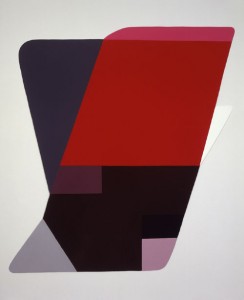
Ruth Root’s paintings have reached their ‘mature-cute’ phase. Spread out evenly along the gallery walls, ten new pieces flaunted a grown up sophistication, with their hyper slick surfaces and tightly controlled geometric divisions. Gone were the little eyes and the smoking cigarettes that characterized previous work, and the hanging was arranged, with a few exceptions, in a traditional way. The paintings may be on their best behavior, but plenty of quirky touches in the relation of form and color still lent a mischievous character to the compositions.
Each untitled painting was an assemblage of overlapping rectangular, square and triangular shapes in various shades of purple, gray and orange with accents of yellow. All had an aerodynamic quality, with rounded edges and were hung flush against the gallery wall. One untitled piece had the look of an airplane fin or an Ellsworth Kelly painting jazzed up with more color. The rounded contours of another evoked the shape of a cartoon speech bubble, waiting to be filled by a jokey text. But what really gave the pieces their idiosyncratic, ironic character were the little blocks of color that appeared out of nowhere, usually accenting the edge of the paintings. Their diminutive size and outrageous colors gave them a cheekiness that pervaded the whole show.
Liam Gillick, at Casey Kaplan
For ‘Flash Art’ magazine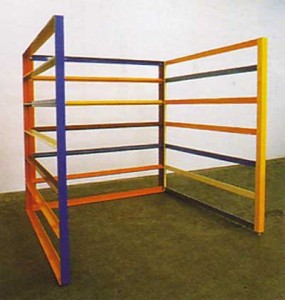
Liam Gillick offered a new take on glitzy art openings by washing the floor of Casey Kaplan’s gallery with cheap vodka and covering it with black glitter. Visitors tracked the sparkly stuff into the main space, where a row of aluminum corrals as colorful as jungle gyms faced a line of black text on the wall opposite. Arranged in a broken Greek key pattern and missing the usual colored Plexiglas panels, Gillick’s architectural sculptures tempted viewers to interact with them. On the wall, a repeated text reading, ‘sit now on a ridge,’ referred to a journey described in the artist’s recent book, ‘Literally No Place’ (a translation of the word utopia), which in turn was inspired by behavioral scientist B.F. Skinner’s proposals to alter human behavior through environmental stimuli.
Without reading Gillick’s book, which was not part of the exhibition, it was next to impossible to understand what was taking place, particularly with the unnecessary glitter and vodka element. The show was elegant but so highly conceptual that viewers who bought the book instead of the art came out ahead. Gillick’s signature retro-chic sculptures are meant to provoke discussion about how the built environment effects human thought and behavior, but it’s only in his writing that these complex investigations into social science are developed. Structured as a series of proposals for fictional stories, the book forces the issue of how space is constructed, and it’s here that the audience is taken ‘literally some place.’
Robert Wogan, at UCU
For ‘Tema Celeste’ magazine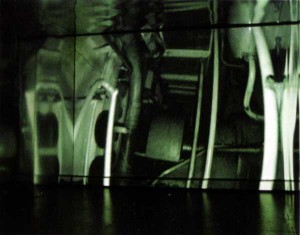
A low light bobs along a gangway in the belly of an abandoned cruise liner accompanied by the sound of heavy breathing and footsteps. It could be a scene from the film Ghost Ship, but it’s a video installation by Robert Wogan, featuring footage from the lower decks of the decommissioned SS United States. The artist made his way through room after room of mechanical apparatus, filming a journey that never seems to end. In a loop lasting just under an hour, Below (United Radiance) perfectly recreated the experience of being lost, complete with a sense of deja vu. It also documented a fall from glory by what was once the fastest and largest ship in the world.
To reach the video at UCU, viewers had to wind their way through two corridors that partially recreated a more elaborate installation from the Liverpool Biennial 2002. The metal-clad gallery walls didn’t come close to reproducing the alien atmosphere of the ship, but did transport viewers into an unfamiliar environment. The video was almost immediately disorienting and at times slightly dizzying as it followed Wogan’s unrelenting progress, never stopping to explore a room or plan a route. While the scenario would be perfect for a horror movie, the artist didn’t hesitate long enough to make his footage scary. Instead, his steady march suggested that the point was not to find a way out, but to cover as much territory as possible.
As the camera delved further and further, the ship’s enormity became apparent. At over five city blocks in length, it was unsurpassed in size and speed when it embarked on its maiden voyage in 1952. Ironically, this was also the year of the first jet airliner, an innovation that essentially paved the way for the ship to go out of service less than twenty years later. Below (United Radiance) is an exploration of loss on an industrial scale, a subject that many contemporary artists explore. The uniqueness of Wogan’s project lies in his selection of an American icon that was once world-renowned, the epitome of progress, but which now languishes in obscurity. In a unique plot twist, during the run of the exhibition, Norwegian Cruise Line bought the ship in order to renovate and recommission it. A tidy story of progress and decline is disrupted as Wogan’s documentary approach reminds us that life doesn’t stop when the cameras do.
Living Inside the Grid, at New Museum of Contemporary Art
For ‘Flash Art’ magazine
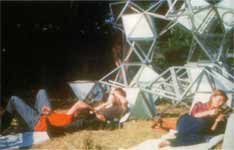
Reporting recently from Baghdad, writer Jon Lee Anderson described an Iraqi man’s assumption that the U.S. population was anti-war because of comments he had heard on American satellite television. This exchange suggested a game of media ping-pong, a ‘us watching them, watching us’ scenario that provided a glimpse of how information is exchanged on a global scale. This kind of sudden insight, and more obvious evidence of how the world is organized in both discrete and interlocked systems, was the subject of ‘Living Inside the Grid.’ At the core of the exhibition concept was curator Dan Cameron’s observation that “…the inhabited grid has become the irreducible sign of the world we live in today.” Cameron supported his assertion by assembling twenty-four artists or artist groups from twelve countries, whose work in some way acknowledges or interacts with the systems that order our worlds.
Surprisingly, the exhibition excluded web-informed artwork. Instead, art in a range of media explored how the concept of the grid, made so pervasive by the Internet, is reapplied to other aspects of life from the intimate to the international. Using themselves as their subject matter, Danica Phelps applied systemization to her life by logging all her art sales, expenses and activities, while the late Israeli artist Absalon videoed himself hitting and kicking at invisible bonds. An impressive sculpture, constructed of common materials used to build fences, by Monica Bonvicini and a portable group of interlocking, triangular plastic ‘Public Things’ by N55 each challenged prepackaged design for the masses. The grid extended to the international level with drawn diagrams outlining conspiracies by Mark Lombardi and a mesmerizing projection of patterns made with three letter airport abbreviations by Langlands and Bell. Rico Gatson’s collages of manipulated movie clips critiqued the dissemination of racial stereotypes, while Tomoko Takahashi’s lighthearted video of shredded paper being thrown from a tower played on a stack of nine monitors.
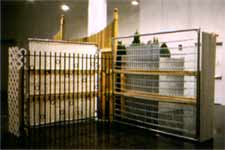
This exhibition proposed that grid systems are so ubiquitous that they are integral to perception and representation. However, the success of this thesis undermines the criteria for selecting artwork for the show by suggesting that most art in touch with contemporary culture would in some way replicate the grid. If fact, several pieces in the show were similar to work by artists who have been more visible recently in New York. For instance, Douglas Blau’s installation of film stills of women in bed strongly recalled Christian Marclay’s video montage and German artist Roland Boden’s portable urban shelters are similar to Andrea Zittel’s live-in units. This only serves to prove Cameron’s point, however, while reminding us that several artists can work in similar ways at one time. ‘Living Inside the Grid’ brings together a variety of diverse artwork under the theme of the grid, but viewers who took time to connect the dots will see patterns emerging in galleries across town.
